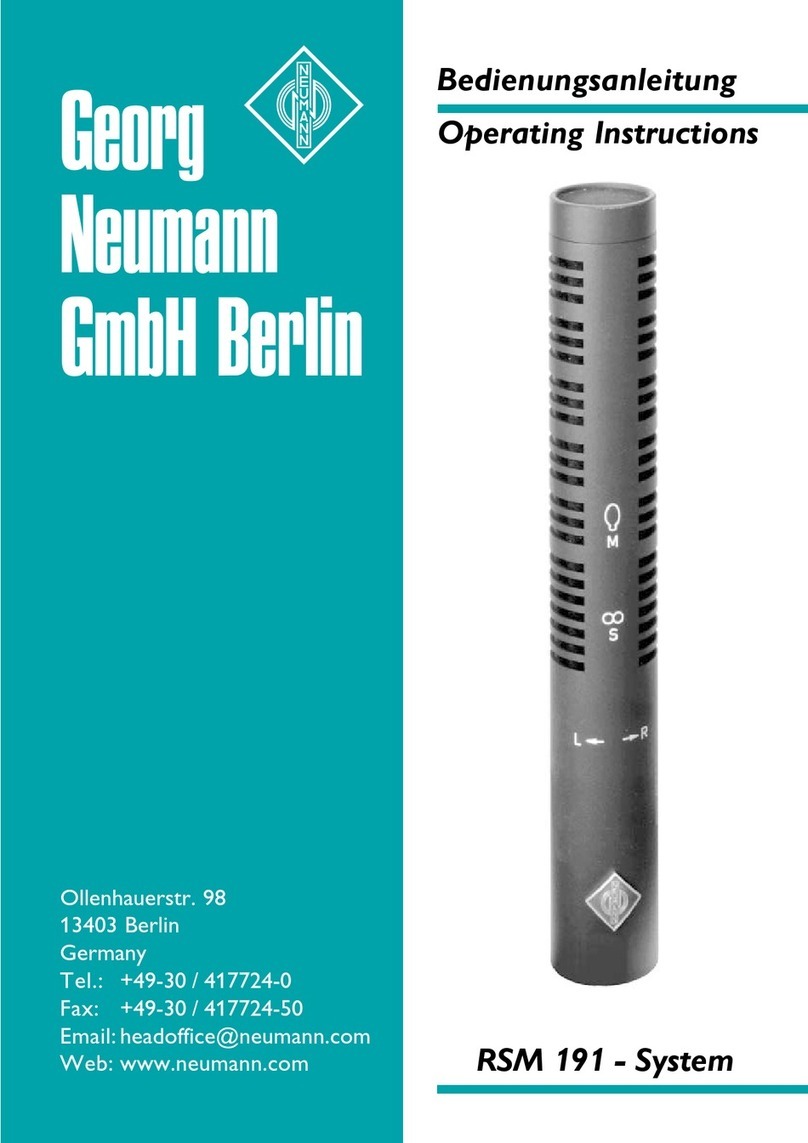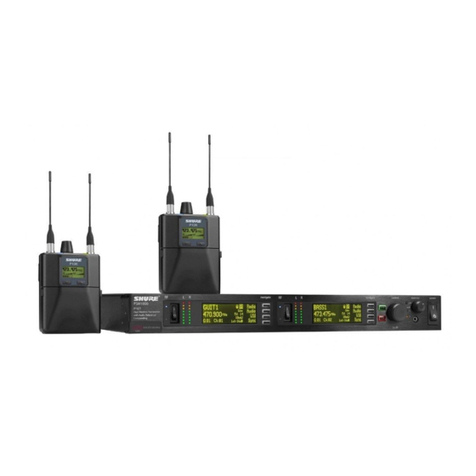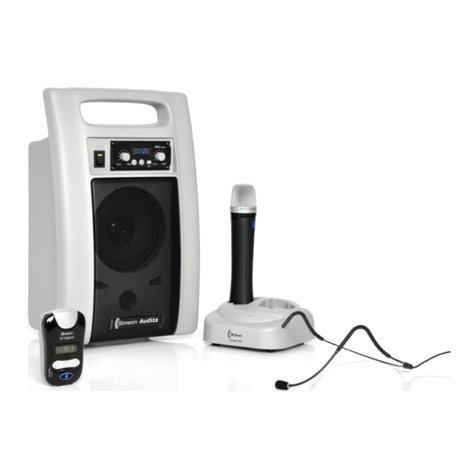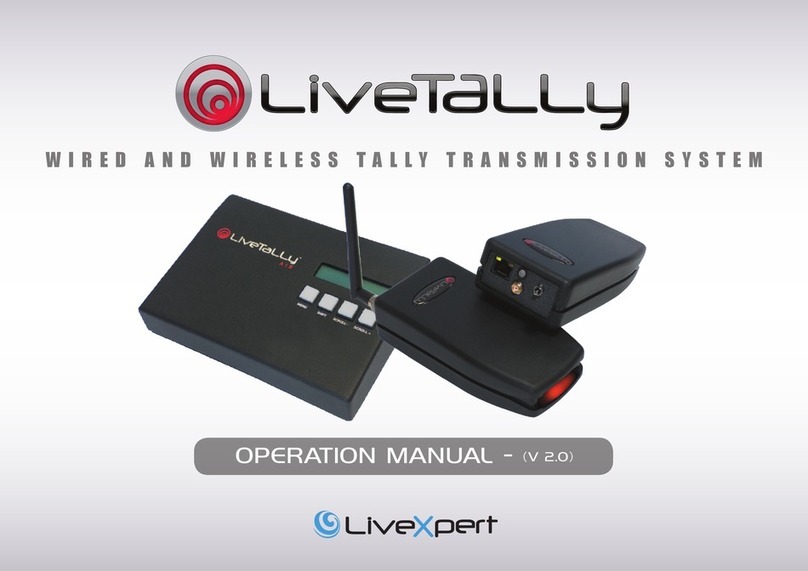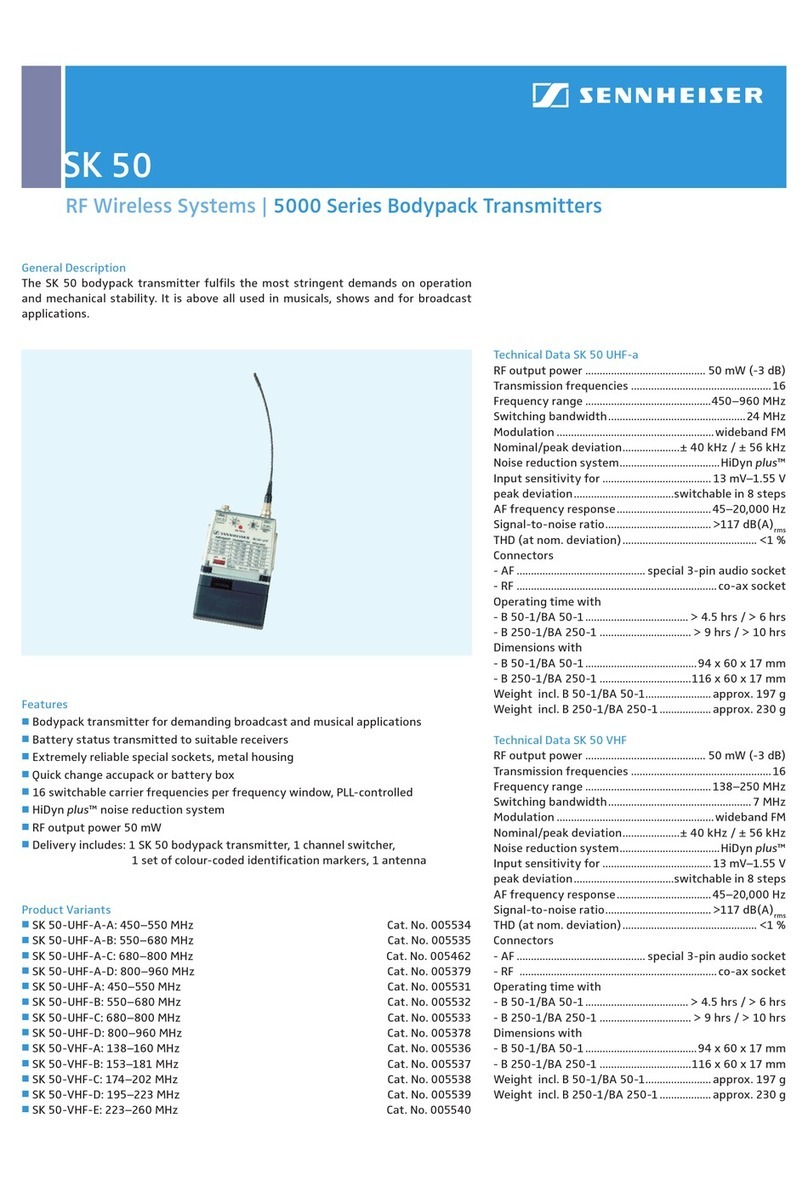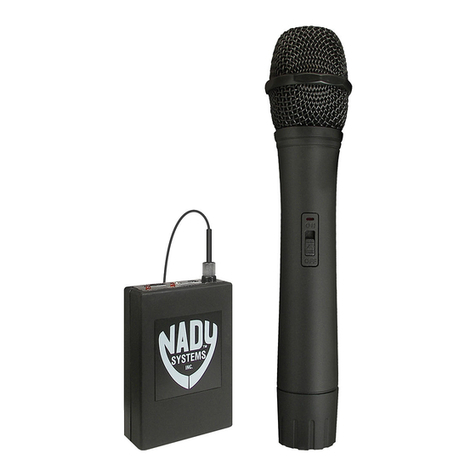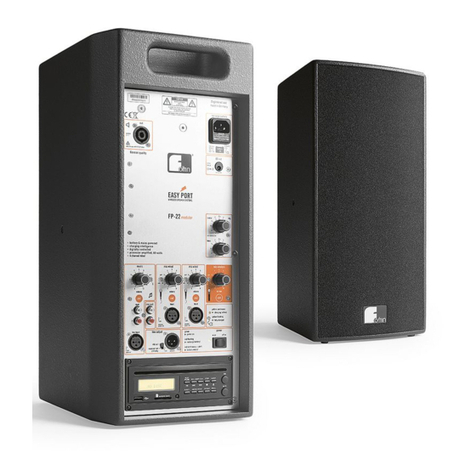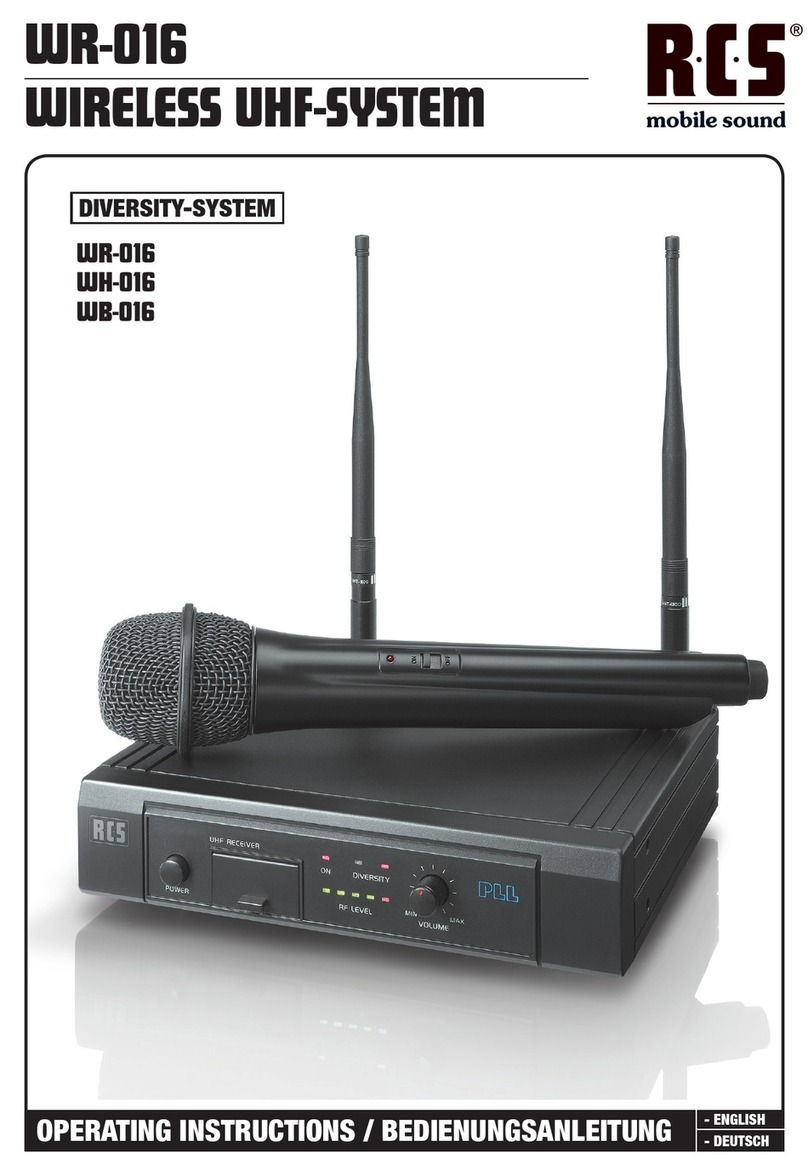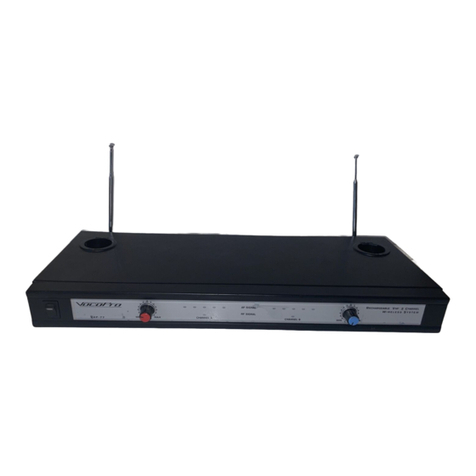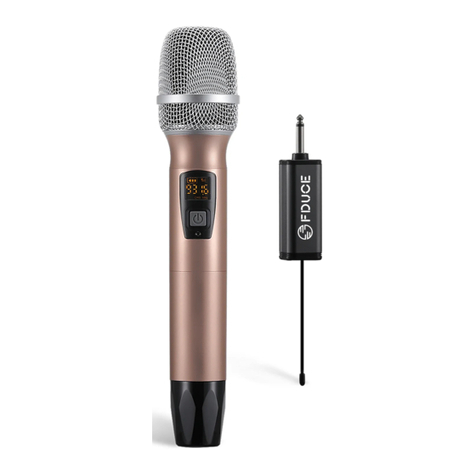Neumann KM 120 User manual

Bedienungsanleitung
Operating Instructions
KM 100 System
Ollenhauerstr. 98
13403 Berlin
Germany
Tel.: +49-30 / 417724-0
Fax: +49-30 / 417724-50
Email: [email protected]
Web: www.neumann.com

3
2
KM 100 F zusätzlich ein Schalter zur Bassabsenkung.
Der Dynamikumfang reicht von ca. 16 dB-A (Ersatz-
geräuschpegel) bis ca. 138 dB SPL (Grenzschalldruck-
pegel). Das sind 122 dB.
2. Das Kleinmikrophon-System
KM 100
2.1 Allgemeines, Beschreibung
KM 100 ist das variable Kondensator-Kleinmikrophon-
System aus der Typenreihe „fet 100®“. Das System
ist variabel, weil es eine Reihe unterschiedlicher Kon-
densatorkapseln mit verschiedenen Richtcharakteri-
stiken anbietet und weil es eine Vielzahl an Zube-
hör gibt, das zwischen die Kapseln und die
Ausgangsstufen geschraubt werden kann. Dadurch
lassen sich die Mikrophone an unterschiedlichste
Aufgaben besonders leicht und gut anpassen. Ein
eventuell im Fernsehbild, auf der Bühne oder im
Konzertsaal sichtbares Mikrophon kann besonders
unauffällig gehalten werden.
KM 100 heißt Kleinmikrophon-System, weil die Mi-
krophone nur 92 mm lang sind und einen Durch-
messer von 22 mm haben. Das Mikrophon besteht
aus der Kondensatorkapsel und der Ausgangsstufe
KM 100. Beide Teile können auseinandergeschraubt
werden. Das Kapselteil kann auf Zubehör wie
• Kabel,
• Kapselverlängerungen,
• Stativgelenke,
• Tischständer,
• Schwanenhälse,
• Stereohalterungen und
• Abhängevorrichtungen
geschraubt werden und ist dabei als Kapselteil nur
ca. 35 mm lang (AK 20: ca. 50 mm).
Die Ausgangsstufe kann über ein nur ca. 3 mm dik-
kes Kabel bis etwa 50 m vom Kapselteil abgesetzt
werden.
Anwendungsempfehlungen für das Kleinmikro-Anwendungsempfehlungen für das Kleinmikro-
Anwendungsempfehlungen für das Kleinmikro-Anwendungsempfehlungen für das Kleinmikro-
Anwendungsempfehlungen für das Kleinmikro-
phonsystem KMphonsystem KM
phonsystem KMphonsystem KM
phonsystem KM 100 sind im Prospekt100 sind im Prospekt
100 sind im Prospekt100 sind im Prospekt
100 sind im Prospekt „„
„„
„KMKM
KMKM
KM 100100
100100
100
Application GuideApplication Guide
Application GuideApplication Guide
Application Guide““
““
“beschrieben.beschrieben.
beschrieben.beschrieben.
beschrieben.
Das KM 100-System gehört zur Typenreihe „fet
100®“, weil die Mikrophonschaltung transformatorlos
arbeitet. Sie ist gekennzeichnet durch:
• besonders hohe Aussteuerbarkeit bei sehr nied-
rigem Eigengeräuschpegel,
Inhaltsverzeichnis
1. Kurzbeschreibung
2. Das Kleinmikrophon-System KM 100
2.1 Allgemeines, Beschreibung
2.2 Die verschiedenen aktiven Kapseln
2.3 Ausgangsstufe KM 100
2.4 Ausgangsstufe KM 100 F
3. Stromversorgung
3.1 Phantomspeisung
3.2 Betrieb mit Netzgeräten
3.3 Batteriespeisung
3.4 Betrieb an unsymmetrischen oder
mittengeerdeten Eingängen
4. Technische Daten
5. Frequenzgänge und Polardiagramme
6. Schaltbild KM 100
7. Zubehör
1. Kurzbeschreibung
KM 100 ist das variable Kondensator-Kleinmikrophon-
System aus der Typenreihe „fet 100®“. Es besteht
aus: aktiven Kapseln mit den Richtcharakteristiken
Kugel, breite Niere, Niere, Niere mit abgesenktem
Bassbereich, Hyperniere und Acht, zwei unterschied-
lichen Ausgangsstufen und umfangreichem Zubehör
für unterschiedlichste Kapselmontage.
Das transformatorlose Schaltungskonzept zeichnet
sich aus durch besonders niedriges Eigengeräusch und
höchste Aussteuerbarkeit, besonders saubere, freie
und verfärbungsfreie Klangübertragung. Die Ausgangs-
stufen haben einen symmetrischen, transformatorlo-
sen Ausgang.
Der 3-polige XLR-Stecker hat jeweils folgende Be-
legung:
Stift 1: 0 V/Masse
Stift 2: Modulation (+Phase)
Stift 3: Modulation (–Phase).
Die Mikrophone werden mit 48 V, 2 mA phantom-
gespeist (IEC 1938). Feldbetriebsübertragungsfaktor
je nach Mikrophonkapsel 10...15 mV/Pa entsprechend
–40...–36 dB re. 1 V/Pa. In den Ausgangsstufen be-
findet sich jeweils ein 10 dB-Schalter zum Absenken
des Übertragungsmaßes, in der Ausgangsstufe
Table of Contents
1. Summarized Description
2. The KM 100 Miniature Microphone System
2.1 General Information, Description
2.2 The Various Active Capsules
2.3 KM 100 Output Stage
2.4 KM 100 F Output Stage
3. Power Supply
3.1 Phantom Powering
3.2 ac Supply Operation
3.3 Battery Powering
3.4 Operation with Unbalanced or Center Tap
Grounded Inputs
4. Technical Data
5. Frequency Responses and Polar Patterns
6. Circuit Diagram KM 100
7. Accessories
1. A Short Description
The KM 100 is the variable condenser miniature
microphone system of the “fet 100®” Series. It con-
sists of: active capsules with the directional charac-
teristics omnidirectional, wide-angle cardioid, cardioid,
cardioid with bass roll-off, hypercardioid and figure-8,
two different output stages and a comprehensive
range of accessories for widely varying methods of
capsule mounting.
The main points of excellence of the transformer-
less circuit design are: remarkably low intrinsic noise
and high output capability and particularly clean, free
and colorless sound reproduction. The output stag-
es have a balanced, transformerless output.
The 3-pin XLR plug connector is wired as follows:
Pin 1: 0 V/ground
Pin 2: Modulation (+phase)
Pin 3: Modulation (–phase).
The microphones are phantom powered at 48 V,
2 mA (IEC 1938). Field sensitivity, depending on
capsule 10...15 mV/Pa, corresponding to –40...
–36 dB re. 1 V/Pa. Both output stages incorporate a
10 dB preattenuation switch, the KM 100 F output
stage has an additional low frequency roll-off switch.
The dynamic range extends from approximately
16 dB-A (equivalent noise level) to approximately
138 dB SPL i.e. 122 dB.
2. The KM 100 Miniature
Microphone System
2.1 General Information, Description
The KM 100 is the variable condenser miniature mi-
crophone system of the “fet 100®” Series. The sys-
tem is variable because it offers a number of differ-
ent condenser capsules with various directional
characteristics and because a wide range of accesso-
ries can be supplied, which are simply screwed be-
tween the capsules and the output stages. The mi-
crophones can thus be easily and effectively used for
an infinitely wide variety of purposes. A visible mi-
crophone in a television scene, on the stage or in the
concert hall can thus be kept extremely small and
unobtrusive.
The KM 100 is called a miniature microphone sys-
tem because the microphones are a mere 92 mm
long and 22 mm in diameter. The microphone con-
sists of the condenser capsule and the KM 100 out-
put stage. Both these parts can be unscrewed from
each other. The capsule section can be screwed to
accessories, such as
• cables,
• capsule extensions,
• stand mounts,
• table stands,
• goosenecks,
• stereo mounts and
• auditorium hangers
and is not more than about 35 mm long (AK 20 ap-
proximately 50 mm).
The output stage can be operated at a distance of
up to 50 m from the capsule section via a cable only
about 3 mm thick.
Application hints for using the KMApplication hints for using the KM
Application hints for using the KMApplication hints for using the KM
Application hints for using the KM 100 Miniature100 Miniature
100 Miniature100 Miniature
100 Miniature
microphone system are described in the catalogmicrophone system are described in the catalog
microphone system are described in the catalogmicrophone system are described in the catalog
microphone system are described in the catalog
“KM“KM
“KM“KM
“KM 100 Application Guide”.100 Application Guide”.
100 Application Guide”.100 Application Guide”.
100 Application Guide”.
The KM 100 system is part of the “fet 100®” Series,
the microphone circuitry being transformerless. The
system is distinguished by:
• particularly high output level with very low intrin-
sic noise,

5
4
• besonders saubere, freie und verfärbungsfreie
Klangübertragung,
• besonders kompakten Aufbau, indem die gesam-
te Mikrophonschaltung als Baustein mit ca. 2 cm2
Grundfläche in Hybridbauweise zusammengefasst
ist.
Die Schaltung befindet sich jeweils im Gehäuse der
Mikrophonkapsel, die damit zur aktiven Kapsel wird.
Dadurch wird bei Verwendung nur der Kapsel, abge-
setzt von der Ausgangsstufe und montiert an einem
Kabel oder auf einem Schwanenhals, die gesamte
hochwertige Mikrophonschaltung abgesetzt. Das hat
zur Folge, dass die Verwendung des Zubehörs kei-
nerlei Einschränkung in der Übertragungsqualität be-
deutet, und dass auch ein langes Kabel zwischen ak-
tiver Kapsel und Ausgangsstufe sehr unempfindlich
gegen äußere Störfelder ist. Erst bei Kabellängen deut-
lich über 50 m macht sich bei dieser Anwendung ein
Abfall im oberen Frequenzbereich bemerkbar.
Allerdings kann die Kabellänge durch starke umge-
bende Störfelder (HF, kapazitive oder induktive Ein-
kopplungen) auf deutlich kleinere Werte begrenzt
werden. Dann sollte nach der mindestens erforder-
lichen Kabellänge auf die Ausgangsstufe des Systems
übergegangen werden, um von dort mit der symme-
trischen Modulationsleitung (z.B. IC 3 mt) störsicher
weiterzugehen. Erst bei (Neumann-) Kabellängen
deutlich über 300 m macht sich bei dieser Anwen-
dung ein Abfall im oberen Frequenzbereich be-
merkbar.
2.2 Die verschiedenen aktiven Kapseln
Es stehen zur Zeit folgende sieben aktive Kapseln
zur Verfügung:
AKAK
AKAK
AK 2020
2020
20 ..................................... sw ............................. Best.-Nr. 08416
Druckgradientenempfänger mit der Richtcharakteristik
Acht, die im Gegensatz zu unseren umschaltbaren
Studiomikrophonen mit nur einer Membran realisiert
ist. Alle Schallkomponenten wirken unmittelbar an
dieser einen Membran ohne die inneren Laufzeiten
bei Doppelmembransystemen. Der obere Teil der
AK 20 lässt sich gegenüber dem unteren verdrehen,
um die Kapsel akustisch ausrichten zu können. Be-
findet sich die bedruckte Kapselhälfte vorne und über
dem Logo der Ausgangsstufe, ist das Mikrophon pha-
senrichtig eingestellt und stimmt mit anderen, seit-
lich besprochenen Mikrophonen überein. Die Verbin-
dung ist schwergängig konstruiert, so dass die Verdre-
hung mit einer langsamen, gleichmäßigen Bewegung
und nicht versehentlich erfolgen kann. Die Kapsel
lässt sich ohne Anschlag beliebig verdrehen.
• remarkably clean and uncolored sound reproduc-
tion,
• extremely compact design, the entire microphone
circuitry of hybrid construction is constituted by a
module measuring only 2 cm2in area.
The circuitry is contained in the case of the micro-
phone capsule, which therefore becomes an active
capsule. Thus, if the capsule is used by itself, sepa-
rately from the output stage and mounted on a ca-
ble or goose-neck, the entire high quality micro-
phone circuitry is separated with it. The result is that
the use of the accessories entails absolutely no im-
pairment of the quality of reproduction and that even
a long cable connection to the active capsule is very
insensitive to external interference fields. Only when
for this application cable lengths are well in excess
of 50 m is any fall-off in the upper frequency range
noticeable.
It must be mentioned, however, that the useful ca-
ble length can be considerably reduced by strong
surrounding interference fields (RF, capacitive or in-
ductive coupling). In such cases, the cable length
should be kept to the bare minimum and the con-
nection to the output stage of the system should be
made, so that from this point, interference can be
eliminated with a balanced modulation lead (e.g.
IC 3 mt). It is only when (Neumann) cables are well
over 300 m that for this application any fall-off in the
upper frequency range becomes apparent.
2.2 The Various Active Capsules
At the time of printing the following seven active
capsules are available:
AKAK
AKAK
AK 2020
2020
20 ..................................... blk .............................. Cat. No. 08416
Pressure gradient transducer with figure-8 polar pat-
tern, which is here realized with a single diaphragm,
in contrast to our switchable studio microphones.
All sound field components reach the diaphragm di-
rectly without the internal path lengths in double di-
aphragm designs. The top part of the AK 20 is ro-
tatable relative to the lower part in order to allow
acoustic alignment of the front side with the logo on
the output stage. When the front side of the cap-
sule with the printed figure-8 symbol is aligned with
the logo, the microphone is phase-aligned and has
the same polarity as other side-entrance micro-
phones. The rotating joint is constructed with some
mechanical resistance, so that the alignment can be
performed with a smooth, slow rotating motion and
cannot happen accidentally. The capsule can be ro-
tated infinitely through 360 degrees.
AKAK
AKAK
AK 3030
3030
30 ..................................... sw ............................. Best.-Nr. 07057
AK 30 ist ein diffusfeldentzerrter Druckempfänger
mit einem im freien Schallfeld wirksamen Höhenan-
stieg (ca. 7 dB bei 10 kHz). Dadurch ist der Frequenz-
gang im diffusen Schallfeld bis 10 kHz eben.
AKAK
AKAK
AK 3131
3131
31 ..................................... sw ............................. Best.-Nr. 07063
AK 31 ist ein freifeldentzerrter Druckempfänger: Das
Übertragungsmaß ist im freien Schallfeld bis 20 kHz
eben, fällt dafür im diffusen Schallfeld oberhalb 5 kHz
ab.
AKAK
AKAK
AK 4040
4040
40 ..................................... sw ............................. Best.-Nr. 07045
AK 40 ist ein Druckgradientenempfänger mit Richt-
charakteristik Niere. Sehr gleichmäßige, zur 0°-Schall-
einfallsrichtung parallele Frequenzkurven. Damit wird
der Aufnahmesektor bis ± 135° ohne Klangfärbun-
gen übertragen.
AKAK
AKAK
AK 4343
4343
43 ..................................... sw ............................. Best.-Nr. 07117
AK 43 ist ein Druckgradientenempfänger mit Richt-
charakteristik Breite Niere. Die Dämpfung beträgt
4 dB bei 90°, 8 dB bei 135° und 11 dB bei 180°. Die
Frequenzgangkurven für den von vorn einfallenden
Schall (±90°) sind bis 12 kHz parallel.
AKAK
AKAK
AK 4545
4545
45 ..................................... sw ............................. Best.-Nr. 07074
Druckgradientenempfänger mit Richtcharakteristik
Niere wie AK 40. Eine akustische Tiefenabsenkung
im Freifeld dient der Unterdrückung von tieffrequen-
ten Störungen (Windgeräusche, Körperschall). Durch
den bei Druckgradientenmikrophonen physikalisch
bedingten Naheffekt ergibt sich bei Nahbesprechung
aus ca. 15 cm Abstand ein ebener Frequenzgang
(Sprachniere).
AKAK
AKAK
AK 5050
5050
50 ..................................... sw ............................. Best.-Nr. 07081
Druckgradientenempfänger mit Richtcharakteristik
Hyperniere. Dämpfung für Schall von den Seiten und
von hinten jeweils ca. 10 dB. Minimale Empfindlich-
keit bei ca. 120° Schalleinfallsrichtung.
2.3 Ausgangsstufe KM 100
KMKM
KMKM
KM 100100
100100
100 ................................ sw ............................. Best.-Nr. 07395
An der Seite der Ausgangsstufe KM 100 befindet sich
ein versenkter und damit gegen unbeabsichtigtes Ver-
stellen gesicherter Schiebeschalter. Mit ihm kann eine
Vordämpfung von 10 dB eingestellt werden. Die
Dämpfung wird erreicht, indem die Kapselspannung
AKAK
AKAK
AK 3030
3030
30 ..................................... blk .............................. Cat. No. 07057
AK 30 is a diffuse-field equalized pressure transduc-
er with a free-field treble boost (approx. 7 dB at
10 kHz). The frequency response in the diffuse
sound field is flat up to 10 kHz.
AKAK
AKAK
AK 3131
3131
31 ..................................... blk .............................. Cat. No. 07063
AK 31 is a free-field equalized pressure transducer.
The sensitivity in the free sound field is flat up to
20 kHz. In the diffuse sound field there is a roll-off
above 5 kHz.
AKAK
AKAK
AK 4040
4040
40 ..................................... blk .............................. Cat. No. 07045
AK 40 is a pressure gradient transducer with cardi-
oid characteristic. The frequency curves are very
even and parallel to 0° sound incidence. Sound
sources within a pickup angle of ± 135° are trans-
mitted without coloration.
AKAK
AKAK
AK 4343
4343
43 ..................................... blk .............................. Cat. No. 07117
The AK 43 is a pressure gradient transducer with
wide-angle cardioid characteristic. Attenuation: 4 dB
at 90°, 8 dB at 135°, and 11 dB at 180°. The fre-
quency response for sound sources within an angle
of ±90° (off axis) is parallel up to 12 kHz.
AKAK
AKAK
AK 4545
4545
45 ..................................... blk .............................. Cat. No. 07074
Pressure gradient transducer with cardioid polar pat-
tern, as AK 40. An acoustic freefield bass roll-off is
utilized to suppress low-frequency interference (wind
noise, structure borne noise). Because of the prox-
imity effect, which is a physical characteristic of pres-
sure gradient microphones, a flat frequency response
is obtained with close speech at a distance of 15 cm
or so (Speech cardioid).
AKAK
AKAK
AK 5050
5050
50 ..................................... blk .............................. Cat. No. 07081
Pressure gradient transducer with a hypercardioid
characteristic. Attenuation of sound incidence from
the side or rear is approximately 10 dB. Minimum
sensitivity occurs at an angle of about 120°.
2.3 KM 100 Output Stage
KMKM
KMKM
KM 100100
100100
100 ................................ blk .............................. Cat. No. 07395
On the side of the output stage KM 100 is a slide
switch which is recessed to prevent inadvertent al-
teration. This can be used to effect 10 dB preat-
tenuation. Attenuation is achieved by reducing the
capsule voltage to one third of nominal. The micro-

7
6
auf ein Drittel ihres Wertes reduziert wird. Die Mi-
krophone können dann Schalldruckpegel bis ca. 150 dB
verzerrungsfrei übertragen (siehe technische Daten).
2.4 Ausgangsstufe KM 100 F
KMKM
KMKM
KM 100100
100100
100 FF
FF
F ............................ sw ............................. Best.-Nr. 07376
Die Ausgangsstufe KM 100 F kann alternativ zur Aus-
gangsstufe KM 100 verwendet werden. Im Gegensatz
zu der frequenzlinearen Ausgangsstufe KM 100 wer-
den bei der Ausgangsstufe KM 100 F Frequenzen
unter 80 Hz mit 6 dB/Oktave abgesenkt. Damit kön-
nen Störungen, die durch Wind- oder Körperschall
entstehen, ausgeblendet werden.
Mit einem Schalter lässt sich die Grenzfrequenz
(–3 dB) von 80 Hz auf 120 Hz erhöhen. Die Filter-
steilheit ist dann 12 dB/Oktave. Ein weiterer Schal-
ter senkt das Gesamtübertragungsmaß um 10 dB.
3. Stromversorgung
3.1 Phantomspeisung
Die Mikrophone der Serie „fet 100®“ werden mit
48 V phantomgespeist (P48, IEC 1938). Bei der Phan-
tomspeisung fließt der Speisestrom vom positiven
Pol der Spannungsquelle über die elektrische Mitte
der beiden Modulationsadern zum Mikrophon. Er
wird hierzu über zwei gleichgroße Widerstände bei-
den Tonadern gleichsinnig zugeführt. Die Rückleitung
des Gleichstroms erfolgt über den Kabelschirm. Zwi-
schen beiden Modulationsadern besteht also keine
Potentialdifferenz. Daher ist mit der Phantomspei-
sung eine kompatible Anschlusstechnik möglich:
Auf die Anschlussdosen können wahlweise auch dy-
namische Mikrophone oder Bändchenmikrophone
sowie die Modulationskabel röhrenbestückter Kon-
densatormikrophone geschaltet werden, ohne dass
die Speisegleichspannung abgeschaltet werden muss.
Der Ausgang eines Phantomspeisegerätes darf auch
auf bereits anderweitig phantomgespeiste Mikro-
phoneingänge gesteckt werden.
3.2 Betrieb mit Netzgeräten
Für die Stromversorgung sind alle P48-Netzgeräte
geeignet, die mindestens 2 mA je Kanal abgeben.
Das entsprechende Neumann P48-Netzgerät hat die
Bezeichnung N 48 i-2.
Es ist zur Stromversorgung zweier Mono-Kondensa-
tormikrophone oder eines Stereomikrophons mit
48 V ± 1 V, maximal 2 x 5 mA, geeignet (siehe auch
phones can then reproduce sound pressure levels
of up to 150 dB without distortion (see technical
data).
2.4 KM 100 F Output Stage
KMKM
KMKM
KM 100100
100100
100 FF
FF
F ............................ blk .............................. Cat. No. 07376
The KM 100 F output stage is an alternative to the
KM 100 output stage. In contrast to the KM 100 out-
put stage with a flat frequency response, the
KM 100 F attenuates frequencies below 80 Hz at
6 dB/octave. This eliminates or suppresses interfer-
ence caused by wind or structure-borne noise be-
fore they reach unprotected inputs of other equip-
ment.
A built-in slide switch allows to raise the cut-off fre-
quency (–3 dB point) from 80 Hz to 120 Hz. Then
the filter slope is 12 dB/octave. An additional slide
switch lowers the sensitivity by 10 dB.
3. Power Supply
3.1 Phantom Powering
The “fet 100®” Series microphones are phantom-
powered at 48 V (P48, IEC 1938). With phantom
powering the dc from the positive supply terminal is
divided via two identical resistors, one half of the dc
flowing through each audio (modulation) conductor to
the microphone, and returning to the voltage source
via the cable shield. Phantom powering provides a
fully compatible connecting system, since no poten-
tial differences exist between the two audio conduc-
tors.
Studio outlets so powered will therefore also accept
dynamic microphones and ribbon microphones as
well as the modulation conductors of tube-equipped
condenser microphones without the need to switch
off the dc supply voltage.
No harm is done even if a phantom power supply
is connected to an outlet which is centrally phantom
powered.
3.2 ac Supply Operation
All P48 power supplies according to IEC 1938, de-
livering at least 2 mA per channel, are suitable for
powering the microphones. The Neumann P48 pow-
er supply unit bears the designation N 48 i-2.
It is designed to power two mono condenser micro-
phones or one stereo microphone at 48 V ± 1 V,
max. 2 x 5 mA. (See Neumann bulletin No. 68832:
Neumann-Druckschrift 68832: „48 V-Phantomspeise-
geräte“). Die Zuordnung der Mikrophonanschlüsse
und die Polarität der Modulationsadern ist am Aus-
gang der Speisegeräte die gleiche wie am Mikrophon.
Das N 48 i-2
besitzt XLR 3-Anschlußbuchsen und
wird in folgenden Varianten geliefert:
NN
NN
N4848
4848
48 i-2 (230i-2 (230
i-2 (230i-2 (230
i-2 (230 V)V)
V)V)
V) ............ sw ............................. Best.-Nr. 06500
NN
NN
N4848
4848
48 i-2 (117i-2 (117
i-2 (117i-2 (117
i-2 (117 V)V)
V)V)
V) ............ sw ............................. Best.-Nr. 06502
3.3 Batteriespeisung
Steht keine Netzspannung zur Verfügung, kann die
Speisung mit einem der Geräte
BSBS
BSBS
BS 4848
4848
48 iiiii(für ein Mikrophon) ......................... Best.-Nr. 06494
BSBS
BSBS
BS 4848
4848
48 i-2i-2
i-2i-2
i-2
(für zwei Mikrophone) ............... Best.-Nr. 06496
erfolgen. Beide Geräte liefern 48 V ± 1 V, maximal
je 5 mA und werden jeweils von einer 9-Volt-Block-
batterie Typ IEC 6 F 22 gespeist.
Das Gerät BS 48 i-2 ist mit 5-poligen, das BS 48 i
mit 3-poligen XLR-Steckverbindern ausgerüstet.
Ein Mikrophon der Serie „fet 100®“ kann mit einem
BS 48 i mindestens 20 Stunden betrieben werden
(siehe auch Neumann-Druckschrift 68832... „48 V-
Phantomspeisegeräte“).
Die Zuordnung der Mikrophonanschlüsse und die
Polarität der Modulationsadern ist am Ausgang der
Speisegeräte die gleiche wie am Mikrophon.
3.4 Betrieb an unsymmetrischen oder
mittengeerdeten Eingängen
Die 48 V-Phantomspeisegeräte BS 48 i, BS 48 i-2
und N 48 i-2 haben gleichspannungsfreie Ausgänge,
so daß für den Anschluß an einen unsymmetrischen
Eingang kein Übertrager erforderlich ist.
ACHTUNG:
Bei Mikrophonen der Serie „fet 100®“ mit der Aus-
gangsstufe KM 100 ist Pin 3 die heiße Phase und Pin 2
muss an Masse gelegt werden (siehe Abbildung 1).
Dies bedeutet eine um
180° gedrehte Phasenla-
ge bei unsymmetrischemunsymmetrischem
unsymmetrischemunsymmetrischem
unsymmetrischem
Betrieb gegenüber ande-
ren Studiomikrophonen.
Beim Mischen muss die-
se Phasenlage berücksich-
tigt werden. (Bei Verwen-
dung der Ausgangsstufe
KM 100 F besteht dieses
Problem nicht).
“Phantom 48 Vdc Power Supplies”). Modulation po-
larity at the power supply is identical with that at the
microphone.
The N 48 i-2 has 3-pin XLR-connectors and is avail-
able in the following versions:
NN
NN
N4848
4848
48 i-2 (230i-2 (230
i-2 (230i-2 (230
i-2 (230 V)V)
V)V)
V) ............ blk .............................. Cat. No. 06500
NN
NN
N4848
4848
48 i-2 (117i-2 (117
i-2 (117i-2 (117
i-2 (117 V)V)
V)V)
V) ............ blk .............................. Cat. No. 06502
3.3 Battery Powering
If a mains power source is not available, power can
be supplied by one of the following units
BSBS
BSBS
BS 4848
4848
48 iiiii (for one microphone) ........................ Cat. No. 06494
BSBS
BSBS
BS 4848
4848
48 iiiii-2-2
-2-2
-2 (for two microphones) ................. Cat. No. 06496
Both units deliver 48 V ± 1 V, at 5 mA maximum
and are powered by a 9 V monoblock battery Type
IEC 6 F 22.
The BS 48 i-2 is equipped with 5-pin XLR-connec-
tors, the BS 48 i with 3-pin XLR-connectors.
A microphone of the “fet 100®” Series can be oper-
ated for at least 20 hours on a BS 48 i. See Neumann
bulletin 68832... “Phantom 48 Vdc Power Supplies”.
The assignment of the microphone terminals and the
polarity of the modulation leads is the same at the
output of the power units as it is at the microphone.
3.4 Operation with Unbalanced
or Center Tap Grounded Inputs
The BS 48 i, BS 48 i-2 and N 48 i-2 48 V phantom
powering units have dc-free outputs, so that no trans-
former is required for connecting to an unbalanced
input.
NOTE:
With microphones of the “fet 100®” Series, pin 3 is
the hot phase, and pin 2 must be connected to earth
(see Fig. 1). This means that the phase relationship
on unbalancedunbalanced
unbalancedunbalanced
unbalanced opera-
tion is reversed by 180°
in comparison with oth-
er studio microphones.
When mixing, phase re-
versal has to be taken
into account. (This prob-
lem does not exist
when using the output
stage KM 100 F).
Abbildung / Figure 1

9
8
Bei vielen anderen als den o. g. Phantomspeisege-
räten liegen nicht nur die Modulationsleitungen zum
Mikrophon auf dem Potential der Speisespannung
von +48 V, sondern auch die vom Speisegerät ab-
gehenden Modulationsleitungen. Für die in der Stu-
diotechnik allgemein
üblichen symmetri-
schen und erdfrei-
en Verstärker und
Mischpulteingänge
ist dies ohne Be-
deutung. Dagegen
wird die Speisespan-
nung beim An-
schluss an einseitig
oder mittengeerde-
te Verstärkereingän-
ge kurzgeschlossen,
und es ist kein Be-
trieb möglich. Es be-
stehen folgende Lö-
sungsmöglichkeiten:
a) In mittengeer-
deten Geräten mit
Eingangsübertrager
(zum Beispiel einige NAGRA-Geräte) kann die be-
treffende Erdverbindung fast immer ohne Nachteile
für die Funktion des Gerätes aufgetrennt werden.
b) In jede abgehende Modulationsleitung kann zur
Abblockung der 48V-Gleichspannung eine RC-Kom-
bination eingefügt werden (siehe Abbildung 2 und
Neumann-Information Nr. 84221).
In the case of many other phantom powering units
(except those mentioned above), not only the mod-
ulation leads to the microphone, but also the out-
going modulation leads from the powering unit, are
at the potential of the feed voltage (+48 V). This is
of no significance for
the balanced, float-
ing amplifier and
mixing console in-
puts in general stu-
dio use. On the
other hand, the
supply voltage will
be short-circuited
when connected to
single-sided or cent-
er tap grounded
amplifier inputs, and
no operation will be
possible. This can
be circumvented as
follows:
a) In center tap
grounded equipment
with input trans-
former (e.g. some NAGRA units), the earth lead can
almost always be disconnected without affecting the
function of the equipment.
b) In every outgoing modulation lead, an RC net-
work can be incorporated to block the 48 Vdc volt-
age. (See Figure 2 and Neumann-Information No.
84222).
4. Technische Daten / Technical Data
Abbildung / Figure 2
1) At 1 kHz into 1 kOhm rated load impedance, 1 Pa corresponds 94 dB SPL.
2) THD of the microphone amplifier at an input voltage equivalent to the capsule
output at the specified SPL.
1) Bei 1 KHz an 1 kOhm Nennabschlußimpedanz, 1 Pa entspricht 94 dB SPL.
2) Klirrfaktor des Mikrophonverstärkers bei einer Eingangsspannung, die der von der
Kapsel beim entsprechenden Schalldruck abgegebenen Spannung entspricht.
Typ / Type KM 120 KM 130 KM 131 KM 143 KM 140 KM 145 KM 150
Akustische Arbeitsweise Druckgradientenempfänger Druckempfänger Druckgradientenempfänger
Acoustic operating principle Pressure gradient transducer Pressure transducer Pressure gradient transducer
Richtcharakteristik
Directional pattern
Übertragunsbereich
Frequency range 20 ... 20.000 Hz 20 ... 20.000 Hz
Feldübertragungsfaktor bei 1 KHz 1)
Sensitivity at 1 KHz 1) 12 mV/Pa 12 mV/Pa 12 mV/Pa 15 mV/Pa 15 mV/Pa 14 mV/Pa 10 mV/Pa
Nennimpedanz
Rated impedance 50 Ohm 50 Ohm 50 Ohm 50 Ohm 50 Ohm 50 Ohm 50 Ohm
Ersatzgeräuschpegel (CCIR 468-3)
Eqivalent SPL (CCIR 468-3) 26 dB 27 dB 25 dB 25 dB 25 dB 26 dB 27 dB
Ersatzgeräuschpegel (DIN / IEC 651)
Eqivalent SPL (DIN / IEC 651) 17,5 dB-A 16 dB-A 16 dB-A 16 dB-A 16 dB-A 17 dB-A 18 dB-A
Geräuschpegelabstand (CCIR 468-3)
S/N ratio (CCIR 468-3) 68 dB 67 dB 69 dB 69 dB 69 dB 68 dB 67 dB
Geräuschpegelabstand (DIN / IEC 651)
S/N ratio (DIN / IEC 651) 76,5 dB 78 dB 78 dB 78 dB 78 dB 77 dB 76 dB
Grenzschalldruckpegel für 0,5 % Klirrfaktor 2)
Max. SPL for less than 0.5 % THD 2) 140 dB 140 dB 140 dB 138 dB 138 dB 138 dB 142 dB
mit Vordämpfung
with preattenuation 150 dB 150 dB 150 dB 148 dB 148 dB 148 dB 152 dB
Dynamikumfang des Mikrophonverstärkers
Total dynamic range ot the microphone amplifier 122,5 dB 124 dB 124 dB 122 dB 122 dB 121 dB 124 dB
Stromaufnahme
Current consumption 2 mA 2 mA 2 mA 2 mA 2 mA 2 mA 2 mA
Gewicht
Weight 100 g 80 g 80 g 80 g 80 g 80 g 80 g
Abmessungen (L x ø)
Dimensions (L x ø) 110 x 24 mm 92 x 22 mm 92
x
22 mm 92
x
22 mm 92
x
22 mm 92
x
22 mm 92
x
22 mm

11
10
°
KM 140
°
KM 143
°
KM 131
5. Frequenzgänge und Polardiagramme
Frequency Responses and Polar Patterns
°
KM 120
KM 130

13
12
6. Schaltbild / Circuit Diagram KM 100
°
°
KM 145
KM 150

15
14
7.9 Mikrophonneigevorrichtungen
7.9.1 Mikrophonneigevorrichtung MNV 21 mt für
das komplette Mikrophon
7.9.2 Mikrophonneigevorrichtung MNV 100 für
das abgesetzte Kapselteil
7.9.3 Mikrophonneigevorrichtung MNV 87 mt für
Stereohalterungen STH 100 und STH 120
7.10 Standrohr SR 100 und
Kabeladapter KA 100
7.11 Elastische Aufhängungen
7.11.1 EA 2124 A mt Elastische Aufhängung
7.11.2 DA-AK Doppelaufhängung für AK
7.11.3 DA-KM Doppelaufhängung für KM
7.12 Mikrophonangel MA
7.13 Windschirme WNS 100, WNS 110,
WNS 120, WS 100
7.14 Windschutzkörbe WKD-AK und WKD-KM
für Doppelaufhängungen
7.15 Windjammer WJ-AK und WJ-KM
7.16 Popschutz PS 15
7.17 Schallbeugungskugel SBK 130
7.9 Auditorium Hangers
7.9.1 MNV 21 mt Auditorium Hanger for the
Complete Microphone
7.9.2 MNV 100 Auditorium Hanger for the
Remote Capsule Section
7.9.3 MNV 87 mt Auditorium Hanger for Stereo
Mounts STH 100 and STH 120
7.10 SR 100 Stand Tube and
KA 100 Cable Adapter
7.11 Elastic Suspensions
7.11.1 EA 2124 A mt Elastic Suspension
7.11.2 DA-AK Double Mount for AK
7.11.3 DA-KM Double Mount for KM
7.12 MA Microphone Fishpole
7.13 Windscreens WNS 100, WNS 110,
WNS 120, WS 100
7.14 WKD-AK, WKD-KM Windscreens for
Double Mounts
7.15 WJ-AK, WJ-KM Windjammers
7.16 PS 15 Popscreen
7.17 SBK 130 Sound Diffraction Sphere
7. Zubehör-Liste
7.1 Kabel
7.1.1 Kabel IC 3 mt zum Anschluss des komplet-
ten Mikrophons bzw. der Ausgangsstufe
7.1.2 Kabel LC 3 KA zum Anschluss des abge-
setzten Kapselteils an die Ausgangsstufe
7.1.3 Adapterkabel AC 30 zum Anschluss der
Stereokombination an MTX 191 (A)
7.2 Matrixverstärker MTX 191 A
7.3 Kapselverlängerungen KVF...
7.4 Stativgelenke
7.4.1 Stativgelenke SG 21/17 mt, DS 21 mt
für das komplette Mikrophon
7.4.2 Stativgelenk SGE 100 für das abgesetzte
Kapselteil
7.4.3 Stativgelenke SG 100, DS 100 für die Kapsel-
verlängerungen KVF...
7.4.4 Schwenkgelenk SG-AK
7.4.5 Doppelstative DS 110, DS 120
7.5 Tischständer, Tischflansch
7.5.1 Tischständer MF 2, MF 3, MF 4, MF 5
7.5.2 Mikrophonfuß mit Schwenkgelenk MF-AK
7.5.3 Tischflansch TF 221 c
7.6 Stativverlängerungen
7.7 Schwanenhälse
7.7.1 Schwanenhals SMK 8 i für das komplette
Mikrophon
7.7.2 Schwanenhälse SMK 100 KA, SMK 100-2 KA
für das abgesetzte Kapselteil
7.8 Stereohalterungen für zwei
abgesetzte Kapseln
7.8.1 STH 100 für XY- und ORTF-Aufstellung
7.8.2 STH 120 für MS-Aufstellung
7. Accessories Listing
7.1 Cables
7.1.1 IC 3 mt Cable for Connecting the
Complete Microphone or the Output Stage
7.1.2 LC 3 KA Cable for Connecting the Remote
Capsule Section to the Output Stage
7.1.3 AC 30 Adapter Cable to connect a Stereo
Combination with MTX 191 (A)
7.2 MTX 191 A Matrix Amplifier
7.3 KVF... Capsule Extensions
7.4 Stand Mounts
7.4.1 SG 21/17 mt, DS 21 mt Swivel Stand
Mounts for the Complete Microphone
7.4.2 SGE 100 Swivel Stand Mount for the
Remote Capsule Section
7.4.3 SG 100, DS 100 Swivel Stand Mounts for
the Capsule Extensions
7.4.4 SG-AK Swivel Mount
7.4.5 DS 110, DS 120 Double Mounts
7.5 Table Stands, Table Flange
7.5.1 MF 2, MF 3, MF 4, MF 5 Table Stands
7.5.2 MF-AK Table Stand with Swivel Joint
7.5.3 TF 221 c Table Flange
7.6 Stand Extensions
7.7 Goosenecks
7.7.1 SMK 8 i Gooseneck for the Complete
Microphone
7.7.2 SMK 100 KA, SMK 100-2 KA Goosenecks
for the Remote Capsule Section
7.8 Stereo Mounts for two
Remote Capsule Sections
7.8.1 STH 100 for XY- and ORTF Method
7.8.2 STH 120 for MS-Method

17
16
Richtrohr-Stereomikrophons RSM 191 bzw. der ak-
tiven Kapseln AK 20 und AK 40. Der Pegel des Sei-
tensignals kann unabhängig von der Wahl der Aus-
gangssignale (MS oder XY) verändert werden. Dies
geschieht mit einem Drehschalter in 3-dB-Schritten
von –9 dB bis +6 dB relativ zum Pegel des Mitten-
signals. Damit ist der Aufnahmewinkel stufenweise
zwischen 60° und 170° einstellbar.
Am Ausgang des Matrixverstärkers liegt wahlweise
das MS- oder das XY-Signal, welches durch Summen-
(X = M + S) bzw. Differenzbildung (Y = M – S) aus
dem MS-Signal gewonnen wird. Die Umschaltung
erfolgt mit einem Drehschalter auf der Frontseite des
MTX 191 A. In beiden Positionen kann eine elektri-
sche Links-Rechts-Vertauschung geschaltet werden,
falls das Mikrophon während der Aufnahme um sei-
ne Achse gedreht wird.
Gegen Störgeräusche unterhalb des Übertragungsbe-
reiches ist im Matrixverstärker ein umschaltbares
Hochpassfilter 40(LIN)/80/200 Hz eingebaut.
Der Matrixverstärker und das Mikrophon werden ent-
weder durch eine handelsübliche 9 V-Blockbatterie
IEC 6 F 22 oder durch externe 48 V-Phantomspei-
sung versorgt. Die Batterie treibt einen Gleichspan-
nungswandler im MTX 191 A, der die Batteriespan-
nung auf 48 V transformiert und somit intern eine
48 V-Phantomspeisung zur Verfügung stellt.
Das RSM 191 wird über das 7-polige Kabel KT 5/KT 6
angeschlossen, zwei aktive Kapseln AK... mit dem
Kabel AC 30. Die Weiterleitung der Modulation er-
folgt über einen 5-poligen XLR-Flanschstecker. Die
abgehenden Modulationsleitungen sind gleichspan-
nungsfrei. Für den Anschluss an unsymmetrische Ein-
gänge stehen Adapterkabel AC ... zur Verfügung.
7.3 Kapselverlängerungen KVF...
Mit Hilfe der Kapselverlängerungen KVF... kann eine
aktive Kapsel ohne weitere Kabel von der Ausgangs-
stufe abgesetzt montiert werden. Der starre Teil der
Kapselverlängerung hat einen Durchmesser von
6,5 mm, der biegsame Teil (Schwanenhals) einen
von 8 mm.
KVFKVF
KVFKVF
KVF 118118
118118
118 KAKA
KAKA
KA ....................... sw ............................. Best.-Nr. 08410
Die gestreckte Länge der KVF 118 KA beträgt ca.
300 mm. Kabellänge: 2,2 m.
Montage an SG 100/DS 100.
KVFFKVFF
KVFFKVFF
KVFF 148148
148148
148 KAKA
KAKA
KA .................... sw ............................. Best.-Nr. 08412
Die Kapselverlängerung KVFF 148 KA unterscheidet
sich von den Kapselverlängerungen KVF 158 KA und
KVF 118 KA durch einen zweiten biegsamen Bereich
von ca. 100 mm auf etwa halber Länge des starren
the RSM 191 shotgun stereo microphone or the ac-
tive capsules AK 20 and AK 40. The level of the side
signal is variable, independent of which output mode
is selected (MS or XY). It is adjusted through a ro-
tary switch in 3 dB steps from –9 dB to +6 dB, rel-
ative to the level of the middle signal. Consequent-
ly the pickup angle is varied in steps between 60°
and 170°.
Depending on the position of the rotary switch
on the front of the matrix amplifier the output
provides either an MS- or XY-signal. The XY-sig-
nal is obtained from the MS-signal by summation
(X = M + S) or subtraction (Y = M – S). In both
modes an electric left-right-inversion is alternatively
possible if during the recording the microphone is
turned upside-down.
To suppress interfering noise below the desired fre-
quency range the matrix amplifier has a switchable
high-pass filter at 40(LIN)/80/200 Hz.
The power for both, the matrix amplifier and the
microphone, is either supplied by a typical 9 V bat-
tery (IEC 6 F 22) or through external 48 V phantom
powering. The battery powers a DC voltage convert-
er inside the MTX 191 A and changes the battery
voltage to 48 V phantom supply.
The connection between the matrix amplifier and an
RSM 191 is made with the 7-pin KT 5/KT 6 cables.
Two AK... active capsules can be connected with an
AC 30 cable. The audio is passed through a 5-pin
XLR flange connector. The output signal is DC-free.
Use AC ... adapter cables to connect the audio to
unbalanced inputs.
7.3 KVF... Capsule Extensions
With the aid of the KVF... capsule extensions, an ac-
tive capsule can be mounted separately from the
output stage without the need for an additional ca-
ble. The rigid part of the capsule extension is 6.5 mm
in diameter, the flexible part (gooseneck) 8 mm.
KVFKVF
KVFKVF
KVF 118118
118118
118 KAKA
KAKA
KA ....................... blk .............................. Cat. No. 08410
The extended length of the KVF 118 KA is approxi-
mately 300 mm. Cable length: 2.2 m.
Mounted on SG 100/DS 100.
KVFFKVFF
KVFFKVFF
KVFF 148148
148148
148 KAKA
KAKA
KA .................... blk .............................. Cat. No. 08412
The KVFF 148 KA capsule extension differs from the
KVF 118 KA and KVF 158 KA capsule extensions by
providing a second flexible section of approximately
100 mm at about the middle of the rigid section.
7. Zubehör-Beschreibung
7.1 Kabel
7.1.1 Kabel IC 3 mt zum Anschluss des komplet-
ten Mikrophons bzw. der Ausgangsstufe
Die akustischen Eigenschaften der Mikrophone wer-
den auch durch sehr lange (Neumann-) Kabel nicht
beeinflusst. Erst bei Kabellängen deutlich über 300 m
macht sich ein Abfall im oberen Frequenzbereich
bemerkbar.
Neumann bietet ein vielfältiges Kabelsortiment an,
von dem hier ein Ausschnitt erwähnt wird. Andere
als die genannten Kabellängen sowie Kabelmaterial
ohne Armaturen sind auf Wunsch lieferbar.
ICIC
ICIC
IC 33
33
3mtmt
mtmt
mt .................................. sw ............................. Best.-Nr. 06543
10 m langes Mikrophonkabel, Durchmesser 5 mm, mit
Doppeldrallumspinnung als Abschirmung. Schwarzmat-
te 3-polige XLR-Steckverbinder.
7.1.2 Kabel LC 3 KA zum Anschluss des abge-
setzten Kapselteils an die Ausgangsstufe
Die aktive Kapsel kann von der Ausgangsstufe abge-
setzt betrieben werden. Dazu wird das Verbindungs-
kabel LC 3 KA benötigt.
LCLC
LCLC
LC 33
33
3KA (5KA (5
KA (5KA (5
KA (5 m)m)
m)m)
m) ................ sw ............................. Best.-Nr. 08408
LCLC
LCLC
LC 33
33
3KA (10KA (10
KA (10KA (10
KA (10 m)m)
m)m)
m) ............. sw ............................. Best.-Nr. 08409
Das Verbindungskabel LC 3 KA ist 5 oder 10 m lang,
Durchmesser 3,5 mm und verbindet die aktiven Kap-
seln AK... mit der Ausgangsstufe KM 100.
7.1.3 Adapterkabel AC 30 zum Anschluss der
Stereokombination an MTX 191 (A)
ACAC
ACAC
AC 30 (530 (5
30 (530 (5
30 (5 m)m)
m)m)
m) ........................................................... Best.-Nr. 08418
Y-Kabel, 5 m lang, zum Anschluss von zwei aktiven
Kapseln, z.B. AK 20 und AK 40 als MS-Stereokom-
bination an den Matrixverstärker MTX 191 (A). Das
wahlweise XY- oder MS-Signal liegt dann am 5-po-
ligen XLR-Ausgang des MTX 191 (A) an, und es kann
der Aufnahmewinkel elektrisch fernumgeschaltet
werden. Die Ausgangsstufen KM 100 werden nicht
benötigt. Die beiden Anschlüsse sind gelb für Nie-
re (Kanal 1) und rot für Acht (Kanal 2) gekennzeich-
net.
7.2 Matrixverstärker MTX 191 A
MTXMTX
MTXMTX
MTX 191191
191191
191 AA
AA
A ....................... sw ............................. Best.-Nr. 07331
Der Matrixverstärker MTX 191 A dient zur Verstär-
kung und Matrizierung der MS-Mikrophonsignale des
7. Accessories Description
7.1 Cables
7.1.1 IC 3 mt Cable for Connecting the
Complete Microphone or the Output Stage
The electroacoustic properties of the microphones
are not affected even by very long (Neumann) ca-
bles. However, if cables are well over 300 m, a fall-
off in the upper frequency range becomes apparent.
Neumann offers a wide range of cables. Only a se-
lection is presented here. Other cable lengths or ca-
ble materials without connectors are available on re-
quest.
ICIC
ICIC
IC 33
33
3mtmt
mtmt
mt .................................. blk .............................. Cat. No. 06543
10 m long microphone cable, 5 mm in diameter, with
double twist (double helix) braiding as shield. 3-pin
XLR connectors, matt black.
7.1.2 LC 3 KA Cable for Connecting the Remote
Capsule Section to the Output Stage
The active microphone capsule can be operated re-
motely from the output stage, for which the LC 3 KA
connecting cable is required.
LCLC
LCLC
LC 33
33
3KA (5KA (5
KA (5KA (5
KA (5 m)m)
m)m)
m) ................ blk .............................. Cat. No. 08408
LCLC
LCLC
LC 33
33
3KA (10KA (10
KA (10KA (10
KA (10 m)m)
m)m)
m) ............. blk .............................. Cat. No. 08409
The LC 3 KA is 5 or 10 m long, 3.5 mm in diame-
ter, and connects the active capsules AK... with the
KM 100 output stage.
7.1.3 AC 30 Adapter Cable to connect a Stereo
Combination with MTX 191 (A)
ACAC
ACAC
AC 30 (530 (5
30 (530 (5
30 (5 mm
mm
m) ............................................................ Cat. No. 08418
Y-cable, 5 m long, to connect two active capsules,
e.g. AK 20 and AK 40 as MS stereo couple directly
to the MTX 191 (A) matrix amplifier. The XY or MS
signal is then available at the 5-pin XLR output con-
nector of the MTX 191 (A), and the recording an-
gle can electrically be remote controlled. The output
stages KM 100 are not required. The connectors are
marked yellow for cardioid (channel 1) and red for fig-
ure 8 (channel 2).
7.2 MTX 191 A Matrix Amplifier
MTXMTX
MTXMTX
MTX 191191
191191
191 AA
AA
A ....................... blk .............................. Cat. No. 07331
The MTX 191 A matrix amplifier is used for ampli-
fying and processing the MS microphone signals of

19
18
7.4.3 Stativgelenke SG 100, DS 100 für die Kap-
selverlängerungen KVF...
SGSG
SGSG
SG 100100
100100
100 ................................... sw ............................. Best.-Nr. 06688
Stativgelenk zur Befestigung einer Kapselverlängerung
KVF ... aus dem variablen Kleinmikrophonsystem
KM 100 auf Stativen, der Gewindeanschluss hat 5/8"-
27-Gang. Ein Reduzierstück zur Verbindung mit 1/2"-
und 3/8"-Gewindezapfen wird mitgeliefert.
DSDS
DSDS
DS 100100
100100
100 .................................. sw ............................. Best.-Nr. 07318
In das DS 100 können zwei Kapselverlängerungen
des KM 100-Systems eingeschnappt und auf ein Sta-
tiv geschraubt werden. Die Kapselverlängerungen
können parallel oder einander gegenüberstehend
montiert werden. Das Doppelstativgelenk hat einen
Gewindeanschluss 5/8"-27-Gang. Ein Reduzierstück
zur Verbindung mit 1/2"- und 3/8"-Gewindezapfen
wird mitgeliefert.
7.4.4 Schwenkgelenk SG-AK
SG-AKSG-AK
SG-AKSG-AK
SG-AK ..................................... sw ............................. Best.-Nr. 08452
Das Schwenkgelenk SG-AK kann zwischen Aktiver
Kapsel und Ausgangsstufe des KM 100 Systems ein-
gefügt werden. Damit kann die Kapsel um max. 90°
geschwenkt und ausgerichtet werden.
In Verbindung mit einer elastischen Aufhängung
EA 2124 A mt und einem Tischflansch ist eine me-
chanisch entkoppelte, unauffällige Untertischmonta-
ge, z.B. für TV-Sprecheranwendungen möglich.
Länge 45 mm, Durchmesser 22 mm.
7.4.5 Doppelstative DS 110, DS 120
DSDS
DSDS
DS 110110
110110
110 .................................. sw ............................. Best.-Nr. 07342
Das DS 110 enthält zwei Schienen zur Aufnahme
zweier Kleinmikrophone. Sie können auf unterschied-
liche Weise montiert werden und erlauben unter-
schiedliche Anordnungen:
1. die parallele Montierung,
2. die ORTF-Montierung, die einen Winkel von 110°
bei 170 mm Abstand einschließen,
3. die Montierung für Intensitätsstereophonie. Die
Mikrophonkapseln sind hierbei unmittelbar über-
einander angeordnet.
Ein Schwinggummi dient zur Körperschallunterdrük-
kung. Der Gewindeanschluss hat 5/8"-27-Gang. Ein
Adapter zur Verbindung mit 1/2"- und 3/8"-Gewin-
dezapfen wird mitgeliefert.
DSDS
DSDS
DS 120120
120120
120 .................................. sw ............................. Best.-Nr. 07343
Das DS 120 hat eine 150 mm lange Schiene, die
7.4.3 SG 100, DS 100 Swivel Stand Mounts for
the Capsule Extensions
SGSG
SGSG
SG 100100
100100
100 ................................... blk .............................. Cat. No. 06688
Swivel mount to attach capsule extensions KVF ... of
the variable KM 100 miniature microphone system
to tripods. It has a 5/8"-27 thread, and a thread
adapter for connecting to 1/2" and 3/8" studs.
DSDS
DSDS
DS 100100
100100
100 .................................. blk .............................. Cat. No. 07318
The DS 100 is designed to hold two capsule exten-
sions of the KM 100 system. It can be screwed onto
a tripod. It is easy to arrange the capsule extensions
in parallel or facing each other. The double mount
has a 5/8"-27 female thread. A threaded adapter for
the connection to 1/2" and 3/8" studs is included.
7.4.4 SG-AK Swivel Mount
SG-AKSG-AK
SG-AKSG-AK
SG-AK ..................................... blk .............................. Cat. No. 08452
The SG-AK swivel mount can be inserted between
active capsules and the output stage of the KM 100
system. The capsule can then be swiveled and ori-
entated through 90°.
In combination with the EA 2124 A mt elastic sus-
pension and a table flange, a mechanically decoupled,
unobtrusive setup can be realised, e.g. for TV news
announcers.
Length 45 mm, Diameter 22 mm.
7.4.5 DS 110, DS 120 Double Mounts
DSDS
DSDS
DS 110110
110110
110 .................................. blk .............................. Cat. No. 07342
The DS 110 is equipped with two brackets to hold
two miniature microphones. Both can be mounted
in various ways allowing three different angular ar-
rangements.
1. Parallel mounting.
2. In ORTF mounting the microphones are at an an-
gle of 110° and the capsules are spaced 170 mm
apart from each other.
3. During mounting for intensity stereophony, the
microphone capsules are positioned above each
other (coincident).
An anti-vibration mount suppresses structure-borne
noise. The DS 110 has a 5/8"-27 female thread. A
threaded adapter for the connection to 1/2" and
3/8" studs is included.
DSDS
DSDS
DS 120120
120120
120 .................................. blk .............................. Cat. No. 07343
The DS 120 has a 150 mm long support bar with
Teils. Die gestreckte Länge der KVFF 148 KA beträgt
ca. 570 mm. Kabellänge: 1,9 m.
Montage an SG 100/DS 100.
KVFKVF
KVFKVF
KVF 158158
158158
158 KAKA
KAKA
KA ....................... sw ............................. Best.-Nr. 08411
Die gestreckte Länge der KVF 158 KA beträgt ca.
700 mm. Kabellänge: 1,8 m.
Montage an SG 100/DS 100.
7.4 Stativgelenke
7.4.1 Stativgelenke SG 21/17 mt, DS 21 mt
für das komplette Mikrophon
SGSG
SGSG
SG 21/1721/17
21/1721/17
21/17 mtmt
mtmt
mt ................... sw ............................. Best.-Nr. 06149
(gehört zum Lieferumfang)
Das Stativgelenk SG 21/17 mt besitzt eine Kunststoff-
klammer zur Aufnahme von Kleinmikrophonen. Es hat
einen Gewindeanschluss 5/8"-27-Gang mit Reduzier-
stück für 1/2"- und 3/8"-Gewindezapfen. Eine weitere
Kunststoffklammer mit 17 mm Durchmesser wird
mitgeliefert. Sie kann bei Bedarf gegen die 21 mm-
Klammer ausgetauscht werden, wenn das Mikrophon
statt am Schaft eleganter am Steckverbinder gehal-
ten werden soll.
DSDS
DSDS
DS 2121
2121
21 mtmt
mtmt
mt .......................... sw ............................. Best.-Nr. 06798
Das Doppelstativ DS 21 mt wurde für den Fall kon-
struiert, daß zwei Kleinmikrophone an einem Ort
benötigt werden, und gestattet, diese einfach und
übersichtlich anzuordnen. Es lässt sich auf Tisch- und
Fußbodenständern ebenso wie an Galgen montieren.
Damit steht auch für alle die Anwendungen, bei de-
nen zum Beispiel aus Gründen der Funktionssicher-
heit grundsätzlich ein zweites Mikrophon am gleichen
Ort einsatzbereit sein muss, ein vorzügliches Hilfs-
mittel zur Verfügung. Das DS 21 mt hat einen Ge-
windeanschluss 5/8"-27-Gang. Ein Reduzierstück zur
Verbindung mit 1/2"- und 3/8"-Gewindezapfen wird
mitgeliefert.
7.4.2 Stativgelenk SGE 100 für das abgesetzte
Kapselteil
SGESGE
SGESGE
SGE 100100
100100
100 ............................... sw ............................. Best.-Nr. 06742
Mit Hilfe des Stativgelenks SGE 100 kann eine Ak-
tive Kapsel des KM 100-Systems auf dem Mikrophon-
fuß MF 2 befestigt werden. Ein Schwinggummi dient
zur Unterdrückung von Körperschallübertragung. Es
hat einen M 6-Gewindeanschluss. Bei der Befesti-
gung auf dem Mikrophonfuß MF 2 wird der dort be-
findliche Schwinggummi entfernt und durch das
SGE 100 ersetzt.
The extended length of the KVFF 148 KA is approx-
imately 570 mm. Cable length: 1.9 m.
Mounted on SG 100/DS 100.
KVFKVF
KVFKVF
KVF 158158
158158
158 KAKA
KAKA
KA ....................... blk .............................. Cat. No. 08411
The extended length of the KVF 158 KA is approx.
700 mm. Cable length: 1.8 m.
Mounted on SG 100/DS 100.
7.4 Stand Mounts
7.4.1 SG 21/17 mt, DS 21 mt Swivel Stand
Mounts for the Complete Microphone
SGSG
SGSG
SG 21/1721/17
21/1721/17
21/17 mtmt
mtmt
mt ................... blk .............................. Cat. No. 06149
(included in the supply schedule)
The SG 21/17 mt stand mount has a plastic clamp
for miniature microphones. It has a 5/8"-27 thread
with an adapter for 1/2" and 3/8" studs. An additional
clamp, 17 mm in diameter, is included. This can be
exchanged if necessary for the 21 mm clamp if the
microphone is required to be held more elegantly by
the connector instead of by the body.
DSDS
DSDS
DS 2121
2121
21 mtmt
mtmt
mt .......................... blk .............................. Cat. No. 06798
DS 21 mt dual microphone mount for use in situa-
tions where two Neumann microphones are re-
quired, e.g. in broadcasting applications. It can be
mounted equally easily on a table or floor stand or
on a boom. This is a real advantage in all situations
where, for instance, a second microphone must be
ready for use at all times at a particular location. The
DS 21 mt has a 5/8"-27 thread. A reducer for 1/2"
and 3/8" studs is also provided.
7.4.2 SGE 100 Swivel Stand Mount for the
Remote Capsule Section
SGESGE
SGESGE
SGE 100100
100100
100 ............................... blk .............................. Cat. No. 06742
The SGE 100 swivel mount is used to fasten an ac-
tive capsule of the KM 100 system together with
LC 3 cable to the MF 2 table stand. A rubber shock
mount suppresses structure-borne noise. The swiv-
el mount has an M 6 thread (6 mm). When attach-
ing the swivel mount to the MF 2 table stand, the
SGE 100 replaces the rubber shock mount of the
table stand.

21
20
7.5.3 Tischflansch TF 221 c
TFTF
TFTF
TF 221221
221221
221 cc
cc
c ............................... sw ............................. Best.-Nr. 07278
Der Tischflansch TF 221 c dient zur unauffälligen
Montage von Komponenten des KM 100-Systems. Er
kann unter eine Tischplatte oder senkrecht an eine
Bühnenkante geschraubt werden und erlaubt damit
die unsichtbare Montage z. B. eines Stativgelenkes
SG 100. Eine in dieses Gelenk geschnappte Kapsel-
verlängerung KV ... ragt dann nur noch durch eine
entsprechende Bohrung nach oben aus dem Tisch
oder über die Rampe.
Zum Tischflansch gehört ein Gummistutzen zur Ent-
kopplung des Mikrophons vom Untergrund.
Gewindestutzen 1/2". Flanschdurchmesser 73 mm.
3 Befestigungsbohrungen, Durchmesser je 5,2 mm.
7.6 Stativverlängerungen
Die Stativverlängerungen STV.. werden zwischen Fuß-
bodenständer (z.B. MF 3, MF 4) und Stativgelenke
(z.B. SG 21/17 mt) geschraubt. Dadurch entstehen
unterschiedlich hohe Tisch- oder Fußbodenstative.
Die STV ... haben eine Länge von 40, 200, 400 oder
600 mm. Durchmesser: 19 mm.
STVSTV
STVSTV
STV 44
44
4 ...................................... sw ............................. Best.-Nr. 06190
STVSTV
STVSTV
STV 2020
2020
20 ................................... sw ............................. Best.-Nr. 06187
STVSTV
STVSTV
STV 4040
4040
40 ................................... sw ............................. Best.-Nr. 06188
STVSTV
STVSTV
STV 6060
6060
60 ................................... sw ............................. Best.-Nr. 06189
7.7 Schwanenhälse
7.7.1 Schwanenhals SMK 8 i für das komplette
Mikrophon
SMKSMK
SMKSMK
SMK 88
88
8iiiii ................................. sw ............................. Best.-Nr. 06181
Der Schwanenhals SMK 8 i hat eine Länge von
360 mm und dient zum elektrischen und mechani-
schen Anschluss eines Mikrophons mit 3-poligem
XLR-Stecker. Eine Kontermutter arretiert das Mikro-
phon klapperfrei und bietet einen gewissen Diebstahl-
schutz. Der Kabelaustritt ist seitlich über dem Ge-
windeanschluss. Kabellänge 4,5 m, Kabelstecker A3M.
Gewindeanschluss: 5/8"-27-Gang zur Befestigung des
Schwanenhalses. Ein mitgeliefertes Reduzierstück er-
möglicht die Befestigung auch auf 1/2"- und 3/8"-Ge-
windezapfen.
7.7.2 Schwanenhälse SMK 100 KA, SMK 100-2 KA
für das abgesetzte Kapselteil
SMKSMK
SMKSMK
SMK 100100
100100
100 KAKA
KAKA
KA ..................... sw ............................. Best.-Nr. 08413
Der Schwanenhals SMK 100 KA hat einen Durch-
messer von nur 8 mm und dient zum Aufbau beson-
7.5.3 TF 221 c Table Flange
TFTF
TFTF
TF 221221
221221
221 cc
cc
c ............................... blk .............................. Cat. No. 07278
The TF 221 c table flange serves to mount compo-
nents of the KM 100 system inconspicuously. It can
be fastened under a tabletop or vertically to the edge
of a stage allowing to hide other attachments, for
example the SG 100 swivel mount. A KV... capsule
extension, when clipped into the SG 100 is the only
visible part above the hole in the table or the front
stage.
The table flange comes with a connecting rubber
piece for acoustic decoupling of the microphone
from the mounting surface.
1/2" threaded stud. Flange diameter 73 mm. 3 mount-
ing holes, diameter 5.2 mm each.
7.6 Stand Extensions
The STV ... stand extensions are screwed between
floor stands (e.g. MF 3, MF 4) and swivel mount (e.g.
SG 21/17 mt) to provide table or floor stands of var-
iable heights.
The STVs are 40, 200, 400 or 600 mm long.
Diameter: 19 mm.
STVSTV
STVSTV
STV 44
44
4 ...................................... blk .............................. Cat. No. 06190
STVSTV
STVSTV
STV 2020
2020
20 ................................... blk .............................. Cat. No. 06187
STVSTV
STVSTV
STV 4040
4040
40 ................................... blk .............................. Cat. No. 06188
STVSTV
STVSTV
STV 6060
6060
60 ................................... blk .............................. Cat. No. 06189
7.7 Goosenecks
7.7.1 SMK 8 i Gooseneck for the Complete
Microphone
SMKSMK
SMKSMK
SMK 88
88
8iiiii ................................. blk .............................. Cat. No. 06181
The SMK 8 i gooseneck is 360 mm long, and is used
for the mechanical and electrical connection of a mi-
crophone with 3-pin XLR connector. A locknut se-
cures the microphone firmly and acts as a safeguard
against theft. Cable outlet at the side via thread con-
nector. Cable length 4.5 m, cable plug A3M.
Thread connector: 5/8"-27 thread for securing the
gooseneck. A reducer is for 1/2" and 3/8" studs is
also included.
7.7.2 SMK 100 KA, SMK 100-2 KA Goosenecks
for the Remote Capsule Section
SMKSMK
SMKSMK
SMK 100100
100100
100 KAKA
KAKA
KA ..................... blk .............................. Cat. No. 08413
The SMK 100 KA is only 8 mm in diameter. It is
used to assemble particularly small table micro-
zwei verschiebbare 1/2"-Gewindeschrauben zur Be-
festigung zweier Mikrophone in ihren Halterungen
enthält. Hierbei sind Abstand und Winkel für die
Anordnung der Mikrophone wählbar. Der Gewinde-
anschluss hat 5/8"-27-Gang. Ein Reduzierstück zur
Verbindung mit 1/2"- und 3/8"-Gewindezapfen wird
mitgeliefert.
7.5 Tischständer, Tischflansch
7.5.1 Tischständer MF 2, MF 3, MF 4, MF 5
MF 2MF 2
MF 2MF 2
MF 2 ..................................... sw ............................. Best.-Nr. 07266
Der Mikrophonfuß MF 2 ist ein kleiner Tischständer
mit Messingfuß, Durchmesser 60 mm, 340 g schwer,
sehr standsicher. Der Ständer ist schwarzmatt lackiert
und steht gleitfest auf einer Moosgummischeibe.
Der 1/2"-Gewindezapfen zur Aufnahme z.B. des Sta-
tivgelenkes SG 21/17 mt ist zur Körperschallunter-
drückung durch ein Gummielement vom Fuß entkop-
pelt.
MFMF
MFMF
MF 33
33
3 ........................................ sw ............................. Best.-Nr. 07321
Der Mikrophonfuß MF 3 ist ein Tischständer mit Eisen-
fuß, 1,6 kg schwer, Durchmesser 110 mm. Der Stän-
der ist schwarzmatt lackiert und steht gleitfest auf ei-
ner Moosgummischeibe. Ein umwendbarer Gewinde-
zapfen und ein mitgeliefertes Reduzierstück ermögli-
chen die Verwendung für 1/2"- und 3/8"-Gewindean-
schlüsse.
MFMF
MFMF
MF 44
44
4 ........................................ sw ............................. Best.-Nr. 07337
Der Mikrophonfuß MF 4 ist ein Fußbodenständer aus
Grauguss, ca. 2,6 kg schwer, Durchmesser 160 mm.
Der Ständer ist schwarzmatt lackiert und steht gleitfest
auf einem Gummiring. Ein umwendbarer Gewinde-
zapfen und ein mitgeliefertes Reduzierstück ermög-
lichen die Verwendung für 1/2"- und 3/8"- Gewinde-
anschlüsse.
MFMF
MFMF
MF 55
55
5 ........................................ gr ............................... Best.-Nr. 08489
Der Mikrophonfuß MF 5 hat eine graue Soft-Touch
Pulverbeschichtung und steht gleitfest und trittschall-
dämmend auf einem Gummiring. Der Stativanschluss
hat ein 1/2"-Gewinde. Gewicht: 2,7 kg, Durchmesser
250 mm.
7.5.2 Mikrophonfuß mit Schwenkgelenk MF-AK
MF-AKMF-AK
MF-AKMF-AK
MF-AK ................................... sw ............................. Best.-Nr. 08453
Der MF-AK ist ein kleiner Tischständer mit Schwenk-
gelenk und integriertem Kapselanschluss. Er wird zwi-
schen Aktiver Kapsel und Ausgangsstufe des KM 100
Systems eingefügt. Der Auslass für das 2,4 m lange
Kabel ist seitlich und nach unten vorgesehen. Der
MF-AK steht auf einer gleitfesten Moosgummischei-
be. Durchmesser 60 mm, Gewicht 285 g.
two movable 1/2" threaded studs. Two microphones
in their mounts can be attached. Any space or an-
gle between the microphones is freely adjustable
within the given limits. It has a 5/8"-27 female thread.
A threaded adapter for the connection to 1/2" and
3/8" studs is included.
7.5 Table Stands, Table Flange
7.5.1 MF 2, MF 3, MF 4, MF 5 Table Stands
MFMF
MFMF
MF 22
22
2..................................... blk .............................. Cat. No. 07266
Small table stand with brass base, 60 mm in diam-
eter, 340 g, very stable. The stand has a matt black
finish and rests on a non-skid rubber disk. The 1/2"
stud for e.g. the SG 21/17 mt stand mount is isolated
against structure borne vibrations by means of a rub-
ber shock mount.
MFMF
MFMF
MF 33
33
3 ........................................ blk .............................. Cat. No. 07321
Table stand with iron base, 1.6 kg, 110 mm in diam-
eter. The table stand has a matt black finish and
rests on a non-skid rubber disk attached to the bot-
tom. A reversible stud and a reducer for 1/2" and
3/8" threads are also supplied.
MFMF
MFMF
MF 44
44
4 ........................................ blk .............................. Cat. No. 07337
Floor stand with grey cast iron base, 2.6 kg, 160 mm
in diameter. The floor stand has a matt black finish
and rests on a non-skid rubber disk attached to the
bottom. A reversible stud and a reducer for 1/2" and
3/8" threads are also supplied.
MFMF
MFMF
MF 55
55
5 ........................................ gr ................................ Cat. No. 08489
Floor stand with grey soft-touch powder coating. It
has a non-skid sound-absorbing rubber disk attached
to the bottom. The stand connection has a 1/2"
thread. Weight 2.7 kg, diameter 250 mm.
7.5.2 MF-AK Table Stand with Swivel Joint
MF-AKMF-AK
MF-AKMF-AK
MF-AK ................................... blk .............................. Cat. No. 08453
The MF-AK is a small table stand with swivel joint,
with 2.4 m cable, connecting directly to the active
capsules of the KM 100 system. It is inserted be-
tween active capsule and KM 100 output stage. Ca-
ble outlets are sideways and on the underside. The
MF-AK is fitted with a nonslip rubber disk. Diame-
ter 60 mm, Weight 285 g.

23
22
7.8.2 STH 120 für MS-Aufstellung
STH 120STH 120
STH 120STH 120
STH 120 ............................... sw ............................. Best.-Nr. 08422
Die Stereohalterung STH 120 nimmt zwei aktive
Kapseln auf, z.B. je eine AK 20 und AK 40 parallel
übereinander für MS-Stereoaufnahmen. Sie ist in ei-
nem Kugelgelenk dreh- und schwenkbar. Das Stativ-
gelenk hat einen Gewindeanschluss 5/8"-27-Gang mit
Reduzierstück für 1/2"- und 3/8"- Gewindezapfen.
7.9 Mikrophonneigevorrichtungen
7.9.1 Mikrophonneigevorrichtung MNV 21 mt für
das komplette Mikrophon
MNVMNV
MNVMNV
MNV 2121
2121
21 mtmt
mtmt
mt ....................... sw ............................. Best.-Nr. 06802
Die Mikrophonneigevorrichtung ermöglicht die Ein-
stellung der Mikrophonneigung bei frei am Kabel hän-
gendem Mikrophon. Die MNV 21 mt besteht aus ei-
ner schwenkbaren Mikrophonklammer zur Aufnahme
eines Neumann-Kleinmikrophons oder KMR 81 und
aus einer Kabelführung mit Drehverschluss.
7.9.2 Mikrophonneigevorrichtung MNV 100 für
das abgesetzte Kapselteil
MNVMNV
MNVMNV
MNV 100100
100100
100 ............................ sw ............................. Best.-Nr. 06811
Mit Hilfe der Mikrophonneigevorrichtung MNV 100
kann eine am Verbindungskabel LC 3 KA montierte
Aktive Kapsel des KM 100-Systems frei am Kabel
abgehängt, gedreht und geneigt werden.
7.9.3 Mikrophonneigevorrichtung MNV 87 mt für
Stereohalterungen STH 100 und STH 120
MNVMNV
MNVMNV
MNV 8787
8787
87 ............................... ni ............................... Best.-Nr. 06804
MNVMNV
MNVMNV
MNV 8787
8787
87 mtmt
mtmt
mt ....................... sw ............................. Best.-Nr. 06806
Die Mikrophonneigevorrichtung besteht aus einer
Kabelhalterung und einem drehbaren 1/2"-Gewinde-
zapfen. Dieser wird in ein Stativgelenk geschraubt,
das Mikrophonkabel wird in die Kabelhalterung ge-
klemmt und dort fixiert. Dadurch wird die Einstellung
der Neigung eines frei an seinem Kabel hängenden
Mikrophons ermöglicht.
7.10 Standrohr SR 100 und
Kabeladapter KA 100
SRSR
SRSR
SR 100 (+100 (+
100 (+100 (+
100 (+ KVFKVF
KVFKVF
KVF 158)158)
158)158)
158) .... sw ............................. Best.-Nr. 07336
Das Standrohr SR 100 ermöglicht in Verbindung mit
einem Mikrophon aus dem KM 100-System, z. B.
KM 140 den Aufbau eines sehr schlanken und un-
auffälligen Standrohrmikrophons.
Zum Anschluss an die Ausgangsstufe KM 100 ist ein
Kabeladapter KA 100 erforderlich.
7.8.2 STH 120 for MS Method
STH 120STH 120
STH 120STH 120
STH 120 ............................... blk .............................. Cat. No. 08422
The STH 120 stereo mount accepts two active cap-
sules, e.g. one each AK 20 and AK 40 parallel and
one above the other for MS stereo recordings. It is
rotatable and swivelable. The swivel mount has a
5/8"-27 thread and a reducer for 1/2" and 3/8" studs
is provided.
7.9 Auditorium Hangers
7.9.1 MNV 21 mt Auditorium Hanger for the
Complete Microphone
MNV 21 mtMNV 21 mt
MNV 21 mtMNV 21 mt
MNV 21 mt ....................... blk .............................. Cat. No. 06802
The MNV 21 mt auditorium hanger for Neumann
miniature microphones comprises a tilting micro-
phone clamp and a cable guide with ring fastener.
The MNV 21 mt allows the microphone tilt to be
adjusted with the microphone freely suspended from
its own cable.
7.9.2 MNV 100 Auditorium Hanger for the
Remote Capsule Section
MNVMNV
MNVMNV
MNV 100100
100100
100 ............................ blk .............................. Cat. No. 06811
The MNV 100 auditorium hanger is used to sus-
pend an active capsule of the KM 100 system freely
from its LC 3 KA interconnecting cable. The assem-
bly can be rotated and tilted to any desired angle.
7.9.3 MNV 87 mt Auditorium Hanger for Stereo
Mounts STH 100 and STH 120
MNVMNV
MNVMNV
MNV 8787
8787
87 ............................... ni ................................ Cat. No. 06804
MNVMNV
MNVMNV
MNV 8787
8787
87 mtmt
mtmt
mt ....................... blk .............................. Cat. No. 06806
The auditorium hanger consists of a cable suspen-
sion and a rotating 1/2" threaded stud. It is used to-
gether with a microphone cable having a swivel
mount. The stud is screwed into the threaded cou-
pling of the swivel mount. Then the microphone can
be tilted while it is suspended from its own cable.
7.10 SR 100 Stand Tube and
KA 100 Cable Adapter
SRSR
SRSR
SR 100 (+100 (+
100 (+100 (+
100 (+ KVFKVF
KVFKVF
KVF 158)158)
158)158)
158) .... blk .............................. Cat. No. 07336
The SR 100 is part of a floor stand designed for the
KM 100 system, for example using a KM 140.
For connecting with the KM 100 output stage, a
KA 100 cable adapter is necessary.
The stand consists of an MF 4 stand and a guide
tube in which an inserted KVF 158 capsule extension
ders zierlicher Tischmikrophone z. B. in Zusammen-
hang mit dem Tischfuß MF 2. Die Schwanenhalslän-
ge beträgt 160 mm. Der SMK 100 KA ist vorgesehen
für eine aktive Kapsel des KM 100-Systems. Das Ka-
bel tritt unten hinten heraus, oberhalb des 5/8"-27-
Gang-Gewindestutzens. Ein Reduzierstück für 1/2"-
oder 3/8"-Gewindestutzen wird mitgeliefert. Das Ka-
bel ist 2,5 m lang und endet mit einem Ringkontakt-
adapter für den Anschluss an die Ausgangsstufe
KM 100 und KM 100 F.
SMKSMK
SMKSMK
SMK 100-2100-2
100-2100-2
100-2 KAKA
KAKA
KA ................ sw ............................. Best.-Nr. 08414
Der Doppelschwanenhals SMK 100-2 KA ist für zwei
aktive Kapseln des KM 100-Systems vorgesehen. Der
Durchmesser beträgt nur je 8 mm. Er dient zum
Aufbau besonders zierlicher Tischmikrophone z. B.
in Zusammenhang mit dem Tischfuß MF 2. Die
Schwanenhalslänge beträgt 160 mm. Die Kabel tre-
ten unten seitlich heraus. Gewindeanschluss für
5/8"-27-Gang, oder für 1/2"- oder 3/8"-Gewindestut-
zen mit mitgeliefertem Reduzierstück. Die Kabel sind
je 2,5 m lang und enden mit je einem Ringkontakt-
adapter für den Anschluss an die Ausgangsstufe
KM 100 und KM 100 F.
7.8 Stereohalterungen für zwei
abgesetzte Kapseln
7.8.1 STH 100 für XY- und ORTF-Aufstellung
STHSTH
STHSTH
STH 100100
100100
100 ............................... sw ............................. Best.-Nr. 07315
Die Stereohalterung STH 100 besteht aus einem
schwenkbaren Stativgelenk, auf das unterschiedliche
Bügel zur Befestigung zweier Aktiver Kapseln des
KM 100-Systems für zwei verschiedene Stereoauf-
nahmeverfahren aufgeschraubt werden können.
Ein Bügel ermöglicht eine Mikrophonanordnung in
ORTF-Technik: Zwei abgesetzte, an Verbindungska-
beln LC 3 KA montierte Kapseln (z. B. AK 40 Nie-
ren-Kapseln) werden in zwei Kunststoffklammern an
den Enden des Bügels geschnappt. Der Membranab-
stand der beiden Kapseln beträgt dann 170 mm mit
einem Versatzwinkel von 110°.
Zwei weitere gegeneinander verschiebbare Bügel er-
möglichen Stereoaufnahmen in Koinzidenztechnik:
Dabei sind zwei Aktive Kapseln (an Kabeln LC 3 KA)
akustisch an einem Ort, jedoch gegeneinander im
Winkel verstellbar angeordnet. Der Versatzwinkel
lässt sich durch Verschieben der Bügel von 30° bis
180° kontinuierlich verändern.
Das Stativgelenk hat einen Gewindeanschluss 5/8"-
27-Gang mit Reduzierstück für 1/2"- und 3/8"-Gewin-
dezapfen.
phones, for example on an MF 2 table stand. The
gooseneck is 160 mm long. The SMK 100 KA is de-
signed for attaching an active capsule of the KM 100
system. The cable is incorporated in the gooseneck
and emerges at the rear, just above the 5/8"-27 fe-
male thread. Included is a thread adapter for 1/2" and
3/8" studs. The cable is 2.5 m long and terminates
with a ring contact adapter fitting onto the KM 100
and KM 100 F output stages.
SMKSMK
SMKSMK
SMK 100-2100-2
100-2100-2
100-2 KAKA
KAKA
KA ................ blk .............................. Cat. No. 08414
The SMK 100-2 KA is designed for directly mount-
ing two active capsules of the KM 100 system. Both
goosenecks are only 8 mm in diameter. They are
employed to mount particularly small table micro-
phones. The goosenecks are 160 mm long. The ca-
bles incorporated in the goosenecks emerge at the
rear, above the 5/8"-27 female thread. A threaded
adapter for 1/2" and 3/8" studs is included. The ca-
bles are 2.5 m long and terminate with a ring con-
tact adapter fitting onto the KM 100 and KM 100 F
output stages.
7.8 Stereo Mounts for two Remote
Capsule Sections
7.8.1 STH 100 for XY- and ORTF Method
STHSTH
STHSTH
STH 100100
100100
100 ............................... blk .............................. Cat. No. 07315
The STH 100 is a stereo mount with a swivel
mount for different accessories to attach two active
capsules of the KM 100 system. Different stereo
recording methods are possible.
One holder enables the configuration of the micro-
phones according to the “ORTF Method”: Two ac-
tive capsules (for example AK 40 cardioid), linked to
LC 3 KA connecting cables, are attached at the end
of the holder with plastic clamps. Then the dia-
phragms of the two capsules are 170 mm apart from
each other and at an angle of 110°.
A different pair of holders allows stereo recordings
according to the “Coincidence Method”: Two active
capsules (linked to LC 3 KA cables) are installed to
be acoustically at one point in space, however, free-
ly adjustable to any angle between 30° and 180°.
The swivel mount has a 5/8"-27 thread. Included is
a thread adapter for 1/2" and 3/8" studs.

25
24
(included in the supply schedule) glides and can be
locked. The guide tube is 20 mm in diameter and
0.8 m in height. The height of the capsule can be
adjusted between 0.95 and 1.45 m.
KAKA
KAKA
KA 100100
100100
100 .................................. blk .............................. Cat. No. 07330
The new KM 100 system accessories connect direct-
ly to the output stages. For older accessories, end-
ing with a 3-pin LEMO plug, the redesigned KA 100
cable adapter connects these accessories to the
KM 100 and KM 100 F output stages. Length: 0.5 m.
7.11 Elastic Suspensions
7.11.1 EA 2124 A mt Elastic Suspension
EAEA
EAEA
EA 21242124
21242124
2124 AA
AA
Amtmt
mtmt
mt ................. blk .............................. Cat. No. 08433
Elastic suspension is recommended to prevent the
microphone from being exposed to strong mechan-
ical vibrations caused by structure borne shock waves.
The EA 2124 A mt has a tilting 5/8"-27 female
thread. A reducer for 1/2" and 3/8" studs is includ-
ed. Matt black finish.
7.11.2 Double Mount DA-AK for AK...
DA-AKDA-AK
DA-AKDA-AK
DA-AK ................................... blk .............................. Cat. No. 08419
The DA-AK elastic suspension mounts two active
capsules in parallel for MS recordings, e.g. AK 20 and
AK 40. It has a swivel mount with 3/8” thread.
7.11.3 Double Mount DA-KM for KM...
DA-KMDA-KM
DA-KMDA-KM
DA-KM .................................. blk .............................. Cat. No. 08420
The DA-KM elastic suspension mounts two minia-
ture microphones in parallel for MS recordings, e.g.
KM 120 and KM 140. It has a swivel mount with
3/8” thread.
7.12 MA Microphone Fishpole
MA (+EAMA (+EA
MA (+EAMA (+EA
MA (+EA 21242124
21242124
2124 AA
AA
Amt)mt)
mt)mt)
mt) ...... blk ...................... Cat. No. 06771
The microphone fishpole is made of carbon materi-
al and fiberglass. It can be extended to 4.2 m. For
storage its length is 1.3 m, the weight 0.5 kg.
The MA has a 3/8" threaded stud. The fishpole
comes with an attached elastic suspension,
EA 2124 A mt, suitable to hold microphones be-
tween 21 mm and 24 mm in diameter.
Das Standrohr besteht aus dem Mikrophonfuß MF 4
und einem Führungsrohr mit 20 mm Durchmesser
und 0,8 m Höhe, in dem eine Kapselverlängerung
KVF 158 (im Lieferumfang enthalten) gleitet und ar-
retiert werden kann. Die Kapselhöhe ist zwischen
0,95 m und 1,45 m einstellbar.
KAKA
KAKA
KA 100100
100100
100 .................................. sw ............................. Best.-Nr. 07330
Das neuere Zubehör des KM 100-Systems kann di-
rekt an die Ausgangsstufen angeschlossen werden.
Älteres Zubehör, das einen 3-poligen Lemo-Steck-
verbinder besitzt, benötigt hierfür den neugestalte-
ten Kabeladapter KA 100. Länge: 0,5 m.
7.11 Elastische Aufhängungen
7.11.1 Elastische Aufhängung EA 2124 A mt
EAEA
EAEA
EA 21242124
21242124
2124 AA
AA
Amtmt
mtmt
mt ................. sw ............................. Best.-Nr. 08433
Um mechanische Erschütterung fernzuhalten, emp-
fiehlt sich die Verwendung einer elastischen Mik-
rophonaufhängung. Die Elastische Aufhängung
EA 2124 A mt besitzt einen schwenkbaren Gewin-
deanschluss 5/8"-27-Gang mit einem Reduzierstück
zur Verbindung mit 1/2"- und 3/8"-Gewindezapfen.
Die Oberfläche ist schwarzmatt.
7.11.2 Doppelaufhängung DA-AK für AK...
DA-AKDA-AK
DA-AKDA-AK
DA-AK ................................... sw ............................. Best.-Nr. 08419
Die Elastische Aufhängung DA-AK ist zur parallelen
Anordnung von zwei aktiven Kapseln vorgesehen, z.B.
AK 20 und AK 40 in MS-Technik. Es hat ein Stativ-
gelenk mit 3/8”-Gewinde.
7.11.3 Doppelaufhängung DA-KM für KM...
DA-KMDA-KM
DA-KMDA-KM
DA-KM .................................. sw ............................. Best.-Nr. 08420
Die Elastische Aufhängung DA-KM ist zur parallelen
Anordnung von zwei Kleinmikrophonen vorgesehen,
z.B. KM 120 und KM 140 in MS-Technik. Es hat ein
Stativgelenk mit 3/8”-Gewinde.
7.12 Mikrophonangel MA
MA (+MA (+
MA (+MA (+
MA (+ EAEA
EAEA
EA 21242124
21242124
2124 AA
AA
Amt)mt)
mt)mt)
mt) ........
........
....sw ..................... Best.-Nr. 06771
Die Mikrophonangel besteht aus Karbon- und Glas-
fiber. Sie kann auf jede gewünschte Arbeitslänge bis
4,2 m ausgezogen werden. Die Transportlänge be-
trägt 1,3 m, das Gewicht 0,5 kg.
Die Angel hat einen 3/8" Gewindezapfen. An der
Angel befindet sich eine Elastische Aufhängung
EA 2124 A mt (im Lieferumfang enthalten) zur Auf-
nahme von Mikrophonen mit 21 mm bis 24 mm
Durchmesser.
7.13 Windschirme WNS 100, WNS 110,
WNS 120, WS 100
Zum Vermeiden von Störgeräuschen, die bei Nah-
besprechung, Windeinfluss oder z.B. bei schnellem
Schwenken des Mikrophongalgens auftreten können,
sind Windschutzeinrichtungen aus offenporigem Po-
lyurethanschaum lieferbar. Diese Windschirme erzeu-
gen keine störenden Resonanzen und beeinflussen
nicht die Richtcharakteristik des Mikrophons. Das
Übertragungsmaß wird im oberen Frequenzbereich
geringfügig gedämpft.
WNSWNS
WNSWNS
WNS 100100
100100
100 ............................. sw ............................. Best.-Nr. 07323
(gehört zum Lieferumfang)
.................................................... rot ............................. Best.-Nr. 07324
.................................................... grün ......................... Best.-Nr. 07325
.................................................... gelb .......................... Best.-Nr. 07326
.................................................... blau ......................... Best.-Nr. 07327
.................................................... weiß ......................... Best.-Nr. 07328
Wind- und Nahbesprechungsschutz: Durchmesser ca.
45 mm. Dämpfung des Windgeräusches ca. 18 dB.
Dämpfung bei 15 kHz ca. 2 dB*.
WNSWNS
WNSWNS
WNS 110110
110110
110 ............................. sw ............................. Best.-Nr. 08535
Wind- und Nahbesprechungsschutz mit erhöhter Ef-
fizienz. Durchmesser 45 mm, Länge 70 mm.
WNSWNS
WNSWNS
WNS 120120
120120
120 ............................. sw ............................. Best.-Nr. 08427
Windschutz für das Mikrophon KM 120 oder die ak-
tive Kapsel AK 20. Dämpfung des Windgeräusches ca.
15 dB. Dämpfung bei 15 kHz ca. 2 dB. Durchmesser
48 mm, Länge 65 mm.
WSWS
WSWS
WS 100100
100100
100 ................................. sw ............................. Best.-Nr. 06751
Durchmesser ca. 90 mm. Dämpfung des Windgeräu-
sches ca. 23 dB. Dämpfung bei 15 kHz ca. 4 dB*.
Farbe schwarz.
* Die Dämpfung des Windgeräusches wurde ohne
elektrisches Filter gemessen, in verwirbelter Luftströ-
mung der Geschwindigkeit 20 km/h, erzeugt von ei-
ner geräuschlos arbeitenden Windmaschine.
7.14 Windschutzkörbe WKD-AK und
WKD-KM für Doppelaufhängungen
Für den Mikrophoneinsatz bei stärkerem Wind sind
Windschutzkörbe WK ... lieferbar.
WKD-AKWKD-AK
WKD-AKWKD-AK
WKD-AK ............................. gr ............................... Best.-Nr. 08423
WKD-AK für zwei aktive Kapseln, z.B. AK 20 und
AK 40, Farbe grau, zu verwenden mit der elastischen
Aufhängung DA-AK.
Dämpfung des Windgeräusches ca. 24 dB. Dämpfung
bei 15 kHz ca. 2 dB. Durchmesser 148 mm, Länge
115 mm.
7.13 WNS 100, WNS 110, WNS 120, WS 100
Windscreens
To protect against noise caused by wind, close talk-
ing, and rapid movement on a boom, opencell poly-
urethane foam windshields are available. These wind-
shields have no disturbing resonances and do not
affect the microphone’s directional characteristic. The
frequency response is only slightly attenuated in the
higher frequency range.
WNSWNS
WNSWNS
WNS 100100
100100
100 ............................. blk .............................. Cat. No. 07323
(included in the supply schedule)
.................................................... red ............................. Cat. No. 07324
.................................................... green ........................ Cat. No. 07325
.................................................... yellow ...................... Cat. No. 07326
.................................................... blue ........................... Cat. No. 07327
.................................................... white ........................ Cat. No. 07328
Wind and pop protection/screen: diameter approx.
45 mm. Wind noise suppression approx. 18 dB. At-
tenuation at 15 kHz approx. 2 dB*.
WNSWNS
WNSWNS
WNS 110110
110110
110 ............................. blk .............................. Cat. No. 08535
Wind and pop protection/screen with improved ef-
ficiency. Diameter 45 mm, length 70 mm.
WNSWNS
WNSWNS
WNS 120120
120120
120 ............................. blk .............................. Cat. No. 08427
Windscreen for the microphone KM 120 or the ac-
tive capsule AK 20. Suppression of wind noise ap-
prox. 15 dB. Attenuation at 15 kHz approx. 2 dB.
Diameter 48 mm, length 65 mm.
WSWS
WSWS
WS 100100
100100
100 ................................. blk .............................. Cat. No. 06751
Diameter approx. 90 mm, black. Wind noise sup-
pression approx. 23 dB. Attenuation at 15 kHz ap-
prox. 4 dB*.
* Values measured in pulsating air currents produced
by a noiseless wind machine at 20 km/h (without
electrical filter).
7.14 WKD-AK, WKD-KM Windscreens
for Double Mounts
When microphones are exposed to strong wind,
WK... windscreens should be used for best perform-
ance.
WKD-AKWKD-AK
WKD-AKWKD-AK
WKD-AK ........................ gr ................................ Cat. No. 08423
WKD-AK is for two active capsules, e.g. AK 20 and
AK 40, color grey. To be used with the elastic sus-
pension DA-AK.
Suppression of wind noise approx. 24 dB. Attenua-
tion at 15 kHz approx. 2 dB. Diameter 148 mm,
length 115 mm.

27
26
WKD-KMWKD-KM
WKD-KMWKD-KM
WKD-KM............................ gr ............................... Best.-Nr. 08424
WKD-KM für zwei Kleinmikrophone, z.B. KM 120 und
KM 140, Farbe grau, zu verwenden mit der elasti-
schen Aufhängung DA-KM.
Dämpfung des Windgeräusches ca. 24 dB. Dämpfung
bei 15 kHz ca. 2 dB. Durchmesser 148 mm, Länge
300 mm.
7.15 Windjammer
Für Windschutzkörbe WK ... sind fellähnliche „Wind-
jammer“ lieferbar, die für den Einsatz bei starkem
Wind vorgesehen sind und eine weitere Winddämp-
fung bewirken, die zu der Dämpfung des Windschutz-
korbes WK ... addiert wird.
WJ-AKWJ-AK
WJ-AKWJ-AK
WJ-AK .................................... gr ............................... Best.-Nr. 08425
Windjammer WJ-AK für WKD-AK. Dämpfung des
Windgeräusches ca. 10 dB. Dämpfung bei 15 kHz
ca. 5 dB.
WJ-KMWJ-KM
WJ-KMWJ-KM
WJ-KM ............................... gr ............................... Best.-Nr. 08426
Windjammer WJ-KM für WKD-KM. Dämpfung des
Windgeräusches ca. 10 dB. Dämpfung bei 15 kHz
ca. 5 dB.
7.16 Popschutz
Popschirme bieten einen sehr wirksamen Schutz vor
den so genannten Popgeräuschen. Sie bestehen aus ei-
nem runden, dünnen Rahmen, der beidseitig mit
schwarzer Gaze bespannt ist.
Popschirme sind an einem etwa 30 cm langen
Schwanenhals montiert. Eine Klammer mit einer
Rändelschraube an dessen Ende dient der Befesti-
gung am Mikrophonstativ.
PS 15PS 15
PS 15PS 15
PS 15 ...................................... sw ............................. Best.-Nr. 08472
Der Rahmendurchmesser beträgt 15 cm.
7.17 Schallbeugungskugel SBK 130
SBKSBK
SBKSBK
SBK 130, 22130, 22
130, 22130, 22
130, 22 mmmm
mmmm
mm .......... sw ............................. Best.-Nr. 07371
Die Schallbeugungskugel SBK 130 kann auf die
Druckempfänger KM 130, KM 131 und KM 183 ge-
steckt werden. Damit wird bei diesen Mikrophonen
der Frequenzbereich zwischen 2 kHz und 10 kHz für
Schalleinfall aus dem vorderen Halbraum um maxi-
mal 2,5 dB angehoben, während Schallanteile aus
dem hinteren Halbraum ab etwa 5 kHz um maximal
2,5 dB abgesenkt werden. Innendurchmesser 22 mm
(aktuelle Version des KM 130/131). Weitere Informa-
tionen finden Sie im Katalog KM 100.
Weitere Artikel sind im Katalog „Zubehör“ beschrie-
ben.
WKD-KMWKD-KM
WKD-KMWKD-KM
WKD-KM ............................ gr ................................ Cat. No. 08424
WKD-KM is for two miniature microphones, e.g.
KM 120 and KM 140, color grey. To be used with the
elastic suspension DA-KM.
Suppression of wind noise approx. 24 dB. Attenua-
tion at 15 kHz approx. 2 dB. Diameter 148 mm,
length 300 mm.
7.15 Windjammers
Fur-like “windjammers” are available as an accesso-
ry for WK... windscreens. Their effect is added to that
of the WK windscreens. During strong wind condi-
tions they ensure an even better suppression of wind
noise.
WJ-AKWJ-AK
WJ-AKWJ-AK
WJ-AK .................................... gr ................................ Cat. No. 08425
Windjammer WJ-AK for WKD-AK. Suppression of
wind noise approximately 10 dB. Attenuation at
15 kHz approximately 5 dB.
WJ-KMWJ-KM
WJ-KMWJ-KM
WJ-KM ................................... gr ................................ Cat. No. 08426
Windjammer WJ-KM for WKD-KM. Suppression of
wind noise approximately 10 dB. Attenuation at
15 kHz approximately 5 dB.
7.16 Popscreen
Pop screens provide excellent suppression of so-
called pop noise. They consist of a round, thin frame
covered with black gauze on both sides.
A gooseneck of about 30 cm (12") in length is
mounted at the popshield. It will be attached to mi-
crophone stands by means of a clamp with a knurled
screw.
PS 15PS 15
PS 15PS 15
PS 15 ...................................... blk .............................. Cat. No. 08472
The frame is 15 cm in diameter.
7.17 SBK 130 sound diffraction sphere
SBKSBK
SBKSBK
SBK 130, 22130, 22
130, 22130, 22
130, 22 mmmm
mmmm
mm .......... blk .............................. Cat. No. 07371
The SBK 130 sound diffraction sphere slips onto the
front of the KM 130, KM 131 and KM 183 pressure
microphones. This affects the frequency response of
the microphones. While sounds coming from the
front-half space are emphasized by up to 2.5 dB be-
tween 2 kHz and 10 kHz, sounds arriving from the
rear-half space are attenuated by a maximum of
2.5 dB in the range above 5 kHz. Inner diameter
22 mm (current version of KM 130/131). For details
see also catalog KM 100.
Further articles are described in the catalog “Acces-
sories”.
AK20 AK 30
AK 43AK 40
N 48 i-2
KM 100
BS 48 i
AK 31
AK 45
AK 50 KM 100 F
BS 48 i-2

29
28
IC 3 mt LC 3 KA
KVF 118 KAMTX 191 A
SGE 100
DS 21 mt
SG 100
AC 30
KVF 158 KA SG 21/17 mt
KVFF 148 KA
STV...
MF-AKMF 5
SMK 8 i
DS 110
TF 221 c
DS 100
DS 120
MF 3MF 2
SG-AK
MF 4

31
30
STH 120 MNV 21 mt
KA 100MNV 87 (mt)
MNV 100
EA 2124 A mt SR 100
SMK 100 KA SMK 100-2 KA STH 100
DA-AK
DA-KM
WNS 120
WNS 100
WS 100 WKD-AK
WJ-KMWJ-AK
WKD-KM
MA
PS 15
WNS 110

Irrtümer und technische Änderungen vorbehalten • Errors excepted, subject to changes
Printed in Germany • Publ. 12/03 74937/A03
SBK 130
This manual suits for next models
6
Table of contents
Other Neumann Microphone System manuals
Popular Microphone System manuals by other brands
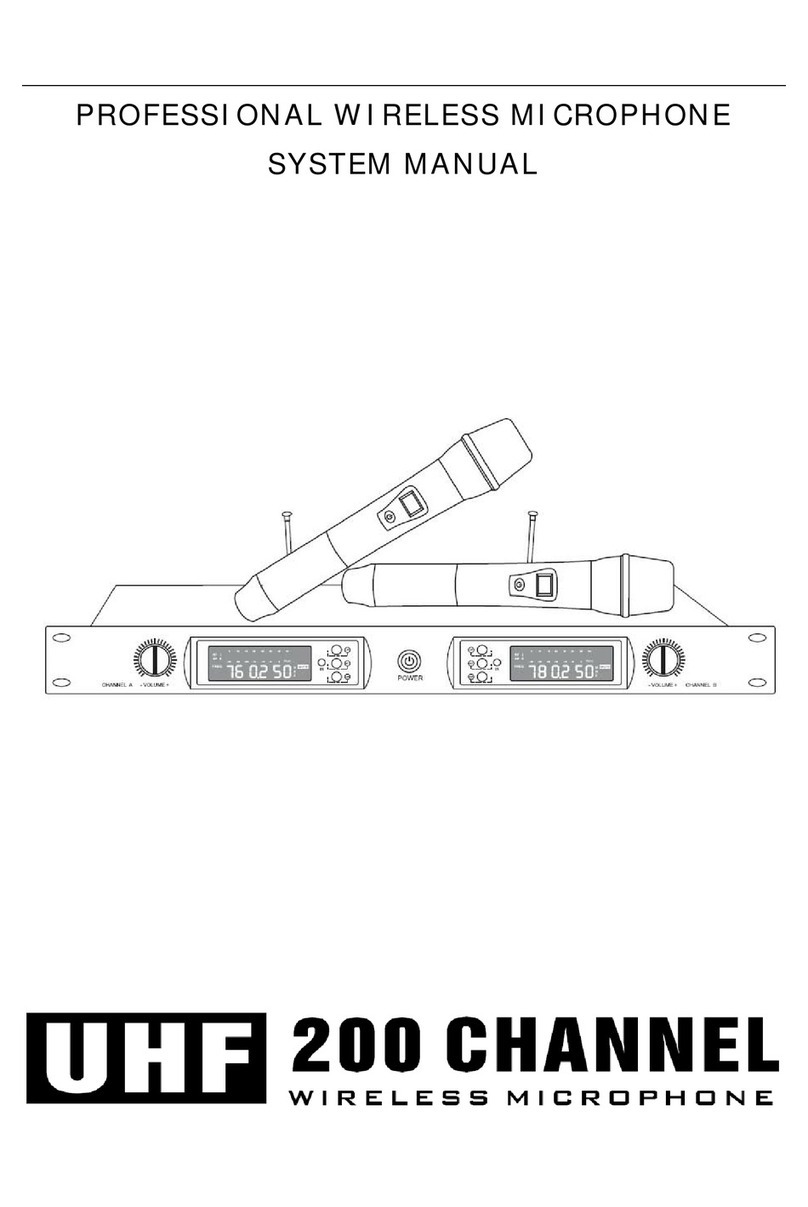
LY International Electronics
LY International Electronics H-66B manual

Precision Digital Corporation
Precision Digital Corporation PDW90 Series instruction manual
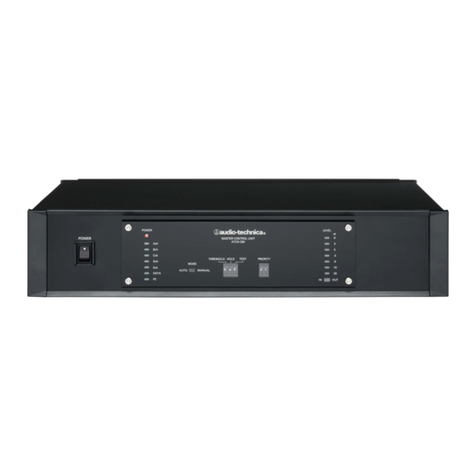
Audio Technica
Audio Technica ATCS-60 instruction manual
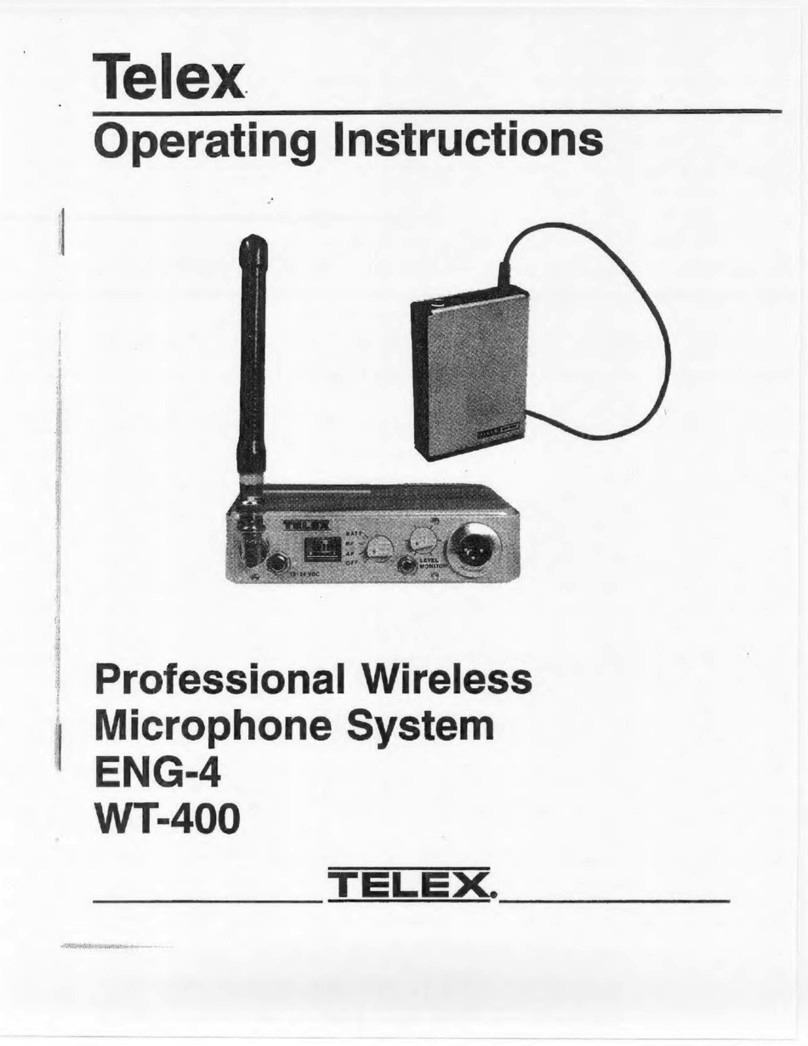
Telex
Telex ENG-4 operating instructions
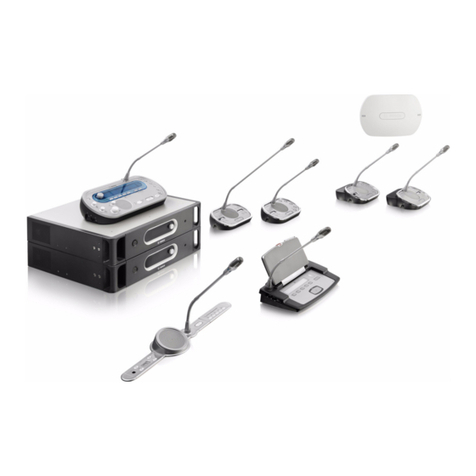
Bosch
Bosch DCN Next Generation Installation & user's instructions

Nissindo
Nissindo LX-2020 G2 Operation manual
